Meghalaya Itinerary 6 Days – Shillong, Dawki & Cherrapunji
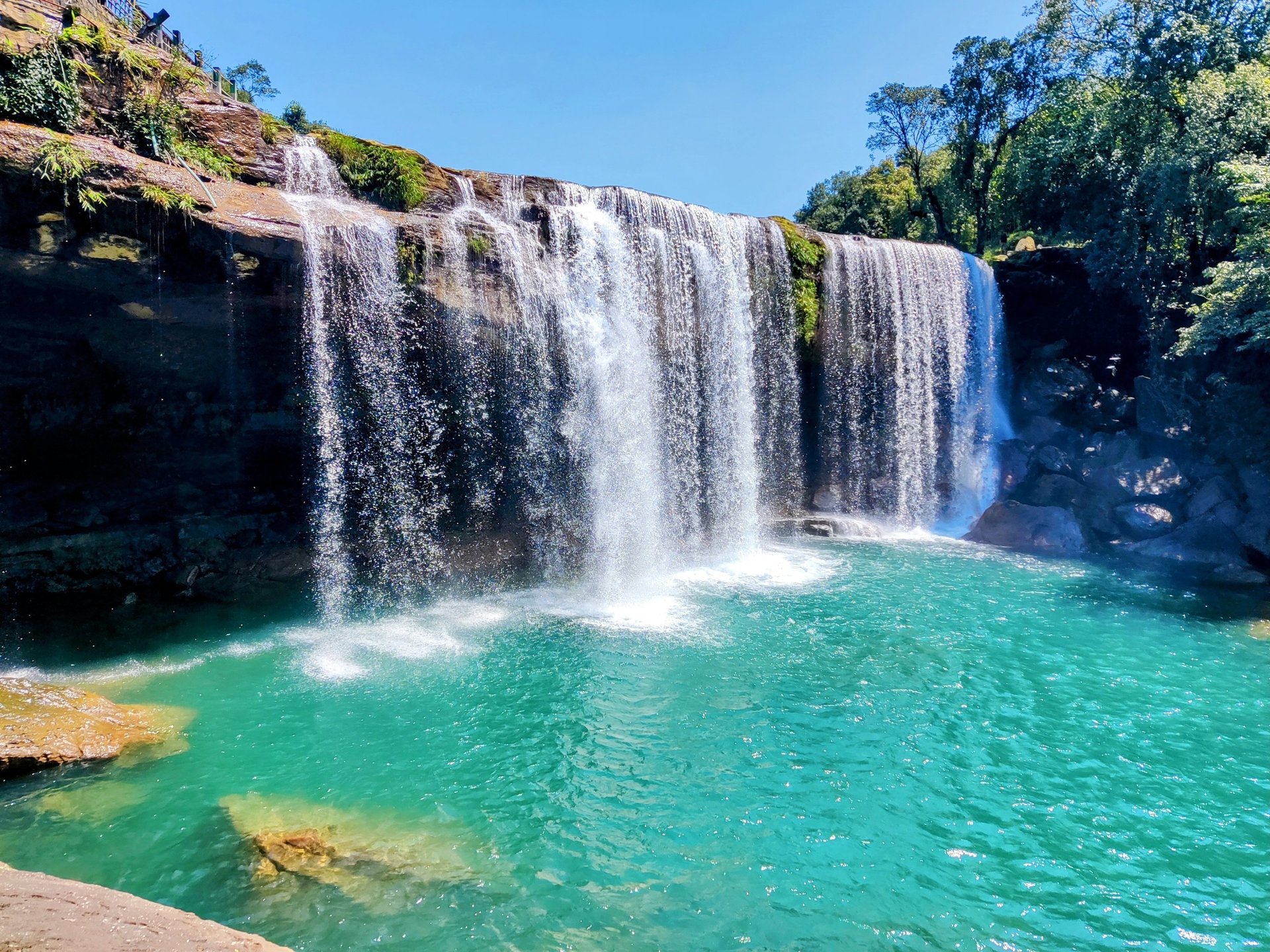
Meghalaya 6-Day Itinerary – Explore Shillong, Dawki, Cherrapunji & Hidden Gems
Your perfect 6-day Meghalaya itinerary for nature, adventure & sightseeing.
Updated on: 28th, July 2025
Explored on: Sept' 2022
A Meghalaya Travel Diary – A Childhood Dream Come True
Meghalaya— the name itself is a little poem: “home of the clouds.” When I first heard it as a kid, I pictured mountains wearing shawls of mist and rivers that never stopped singing. I later learned that the wettest places on Earth— Mawsynram & Cherrapunji— sit here, too. From that day, visiting Meghalaya became a promise I kept in my travel diary.
September 2022 — a month etched in memory, when I finally stepped into the misty embrace of Meghalaya, a dream that had lived on my bucket list for years. I found myself walking through pine forests, chasing waterfalls, and breathing in the magic of the Northeast India I had only imagined.
This dreamy state is divided into three enchanting regions: the Khasi Hills, the Jaintia Hills, and the Garo Hills. Each whispers its own song, steeped in culture, waterfalls, and emerald landscapes. But if you're stepping into Meghalaya for the first time, there’s a well-loved trail that captures the very soul of this land — the Shillong–Cherrapunji–Dawki circuit.
How to get to Meghalaya
Getting to Meghalaya is easy, and the journey itself feels like the start of an adventure.
If you’re flying, the nearest airport is Shillong Airport (also called Umroi Airport), just 30 km from the city. It has daily direct flights from Kolkata and connecting flights from other major cities.
For more flight options, Guwahati Airport is your best bet. Located about 115 km from Shillong, it connects to most cities across India with direct flights.
If you're coming by train, Guwahati Railway Station is the nearest major railhead, about 100 km from Shillong, and is well-connected to the rest of the country.
Once you reach Shillong, the best way to explore Meghalaya is by hiring a local cab with a driver. This makes traveling to waterfalls, hidden villages, and living root bridges smooth and easy—especially since Google Maps can’t always be trusted in these misty hills.
Expect to pay INR 3000 to 5500 per day for a cab, depending on the route and car type.
Best Time to Visit
There’s no one perfect time to visit Meghalaya—each season brings its own charm.
If you love lush green hills and roaring waterfalls, then the Monsoon Season (July to October) is a beautiful time. The rains bring Meghalaya to life, especially in places like Cherrapunji and Shillong.
But if you want to go trekking or see the crystal-clear waters of the Umngot River in Dawki, then Winter (November to January) is the best. The skies are clear, the views are stunning, and the river shines like glass.
No matter when you go, Meghalaya never fails to amaze.
Begin your journey in Shillong, the vibrant capital of Meghalaya, often called the "Scotland of the East." With its pine-clad streets, colonial charm, and café culture, Shillong makes for the perfect base. From here, the road unwinds like a melody, leading you deeper into the hills.
Next comes Cherrapunji or Sohra, one of the Wettest Places on Earth. Here, clouds drift low over living root bridges, waterfalls plunge into deep gorges, and every corner feels like a scene from a dream. Whether it’s Nohkalikai Falls, Mawsmai Caves, or a trek to Double Decker Root Bridge in Nongriat, Cherrapunji is where nature writes poetry in mist and moss.
And then there’s Dawki, where the Umngot River flows so crystal-clear, it seems like boats float on air. Bordering Bangladesh, this serene town offers a peaceful escape with scenic river rides, limestone cliffs, and unforgettable sunsets.
Together, Shillong, Cherrapunji, and Dawki form a travel circuit that blends adventure, tranquility, and natural beauty — ideal for a Meghalaya itinerary for 6-7 days. Whether you're chasing waterfalls, sipping local tea, or tracing poetry on paths unknown, this journey will leave you spellbound.
So pack your bags, let curiosity guide you, and follow the call of the clouds — because in Meghalaya, every road is a rhyme waiting to be told.
A Day-by-Day Travel Guide


Start from Shillong, calm and bright,
Pine trees sway, and skies are light.
Colonial charm and café scenes,
A hill town wrapped in emerald greens.
Next to Cherrapunji’s misty call,
Where waterfalls dance and raindrops fall.
Walk on living root bridges wide,
With clouds and moss on every side.
To Dawki next, where rivers gleam,
And boats float gently through a dream.
The Umngot’s glass—so pure, so clear,
Feels like a world not bound by year.
So pack your bags, the clouds invite,
With trails that dance in soft twilight.
For every step, each turn, each climb—
In Meghalaya, all roads rhyme.
Day 1: Arrival in Shillong – Where the Hills Begin to Hum
The journey to Meghalaya doesn’t begin at a destination — it begins in a feeling. A shift in the air, a softening of the light, a whisper from the hills that tells you you’ve arrived somewhere different. Whether you’re driving up from Guwahati or landing directly at Shillong Airport, Day 1 welcomes you gently into the arms of the Khasi Hills — and there’s no better first embrace than Umiam Lake, the first wonder waiting just before you reach Shillong city.
First Glimpse of Meghalaya’s Heartbeat: Umiam Lake (Barapani)
About 17 kilometers before Shillong, the road opens up to reveal Umiam Lake — a vast, mirror-like stretch of water cradled between rolling green hills. Often called Barapani by locals, this reservoir is more than just a scenic stop; it’s an emotion, a quiet prelude to the days of discovery ahead.
Formed in the 1960s as part of a hydroelectric project, Umiam Lake has since become a beloved landmark, not just for its purpose but for its peace. The name “Umiam” translates to “water of tears” — inspired by an ancient Khasi legend where two celestial sisters were separated during a journey to Earth, and one’s tears filled the valley below, becoming this lake. It’s the kind of story that lingers as you stand at the edge of the water, watching clouds drift across the surface and pine trees sway on the hills beyond.
If time allows, pause here longer. The Umiam Water Sports Complex offers boating, kayaking, and water cycling — a refreshing start for those eager to jump into Meghalaya’s adventure side. Or take the slower route: sit on a bench at Nehru Park, sip a cup of local tea, and let the landscape ease your senses into the rhythm of the highlands. The mornings here are often misty, the evenings golden — both times equally magical for photography.
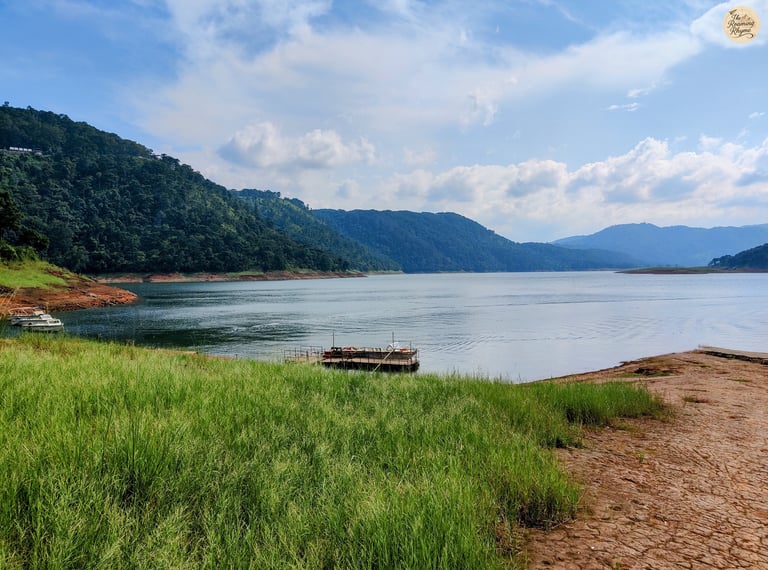

Umiam Lake – Where Meghalaya’s Hills Meet a Mirror of Stillness
Into the Hill City: Shillong Beckons
As you continue your drive into Shillong, the road gently winds uphill, trees thickening around you, the air cooler and cleaner. You’ll soon notice the unique character of this hill capital: a blend of old-world charm and modern bustle, where colonial-era buildings meet colorful cafés, and where the laughter of schoolchildren mixes with the notes of distant guitar music.
Shillong feels alive — not in a rushed way, but in a rhythm all its own. Neatly paved roads, walkable bazaars, pine-scented lanes, and lively street corners invite you to pause often. Known as the “Scotland of the East”, the city wears that name not just for its scenic charm but for its soul — creative, musical, and quietly proud.
Check into your hotel, preferably somewhere around Police Bazar, the city’s vibrant core. Staying here gives you easy access to markets, eateries, and cultural hubs — and if you’re someone who likes to wander with no agenda, this neighborhood will serve you well.
Take some time to freshen up and relax. Let the journey settle into your bones. Then, as dusk approaches, step out again — because Shillong has more stories to tell.
Evening Vibes: A Walk Through Police Bazar
As twilight falls over the hills, Police Bazar begins to glow — not just with lights, but with life. This bustling market area is where locals shop, vendors call out, and visitors blend in, all under a sky that deepens into blue.
Wander through rows of stalls and shops selling handwoven Khasi shawls, bamboo crafts, beaded jewelry, and woollens that seem made for mountain days. You’ll find street food carts steaming with momos, thukpa simmering in large pots, and locals gathering around roasted corn stands or tea counters, swapping stories as the city winds down.
If you're hungry, step into one of the cozy restaurants nearby — from traditional Khasi kitchens to fusion cafés, there’s something for every taste. Don’t miss trying Jadoh — a flavorful rice and meat dish, or Tungrymbai, a spicy fermented soybean delicacy that’s unique to this region.
But even if you don’t stop to eat, just strolling through this space is a window into Shillong’s heartbeat. You’ll see college students with guitars, elderly women wrapped in wool shawls, young entrepreneurs setting up night stalls — all moving to the gentle pulse of the city.
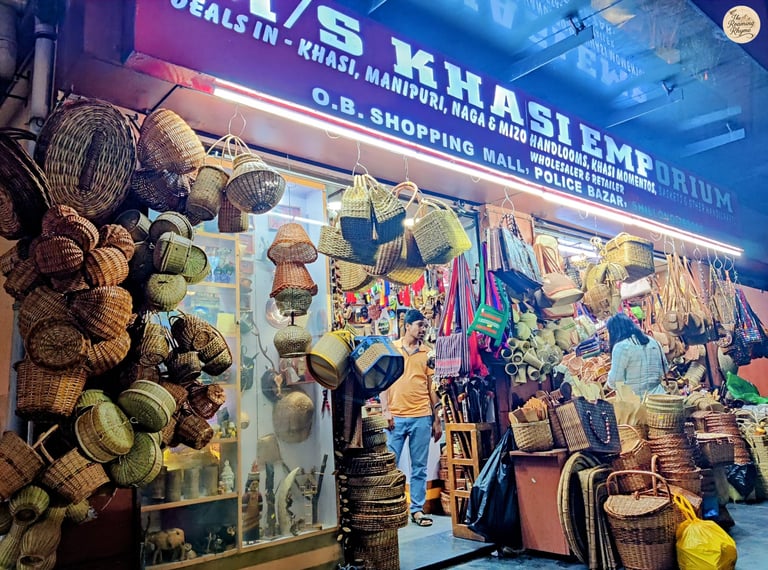

Colors of Culture – Khasi Handicrafts at Police Bazar, Shillong
A Night to Rest, a Journey Just Begun
End your first day soaking in the cool mountain breeze and the buzz of the city. Get a good night’s rest — tomorrow, Day 2 takes you beyond the city into sacred forests, waterfalls, and panoramic hilltop views.
This is just the beginning — and already, Meghalaya is starting to hum in your soul.
Day 2 – Where Clouds Whisper and Forests Remember: Exploring Shillong's Soul
The skies in Meghalaya don’t wait long to wake up. By 4 AM, the first light gently touches the hilltops, and the city begins to stir. It’s best to start your day early here — you’ll find more time to explore and a softer glow in everything you see. After a hearty breakfast at your stay in Shillong, set out around 8 AM. Today, you’ll be heading out of the city for a beautiful loop of nature, culture, and quiet wonder — all within a day’s reach.
Touching the Sky: Shillong Peak
Your journey begins with a winding drive uphill — 8 km south of the city, a turn in the road takes you towards Shillong Peak, the highest point in Meghalaya. As your vehicle climbs slowly through misty bends and pine-scented air, the noise of the city fades, replaced by birdsong and breeze.
At 1,965 meters above sea level, Shillong Peak opens up into a panorama that feels like a painting in motion. The entire city of Shillong lies beneath you — its rooftops tucked among the hills, clouds casting shadows over forest canopies, and on clear days, even the plains of Bangladesh shimmer on the horizon. A viewing tower stands tall here, offering even more striking views through telescopes — a dream come true for photographers and sky-watchers alike.
But Shillong Peak is more than just a viewpoint. It holds spiritual weight in Khasi culture. The name ‘Shillong’ is believed to have come from Lei Shyllong, a local guardian spirit who is said to dwell on this very hilltop, watching over the land and its people. Locals still gather here during spring to offer prayers and perform rituals — a quiet tradition carried on under the open sky.
A note for visitors: This peak lies within an Indian Air Force zone. Entry is allowed, but you’ll need to show valid ID at the gate. Cameras must be deposited at the check post, and photography is only allowed from the designated areas. Foreign tourists are not currently permitted.
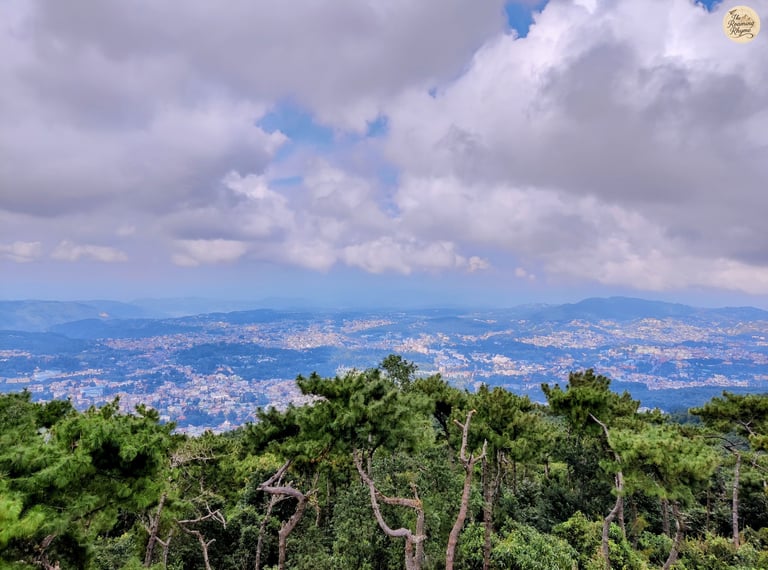

Shillong Peak – The City Beneath the Clouds
The Song of Water: Elephant Falls
Descending from the heights of Shillong Peak, continue on the same route toward Elephant Falls — one of the most beloved waterfalls in all of Meghalaya. Known in the local Khasi tongue as Ka Kshaid Lai Pateng Khohsiew, which means “Three-Step Waterfall", this spot truly lives up to its name.
Each tier of the waterfall has a personality of its own. The first is gentle and hidden behind trees — a quiet start. The second flows thinner and cleaner, almost like a silver ribbon falling through green foliage. And then comes the third — a bold and dramatic cascade that pours down a rocky face, surrounded by the hum of leaves and the scent of fresh earth. You’ll walk down around 150 steps to reach the base, but every step brings you closer to its cool mist and mesmerizing rhythm.
The waterfall got its English name from a large elephant-shaped rock that once stood beside it — sadly destroyed in the 1897 earthquake, but its memory lives on in the name. This spot is perfect for photography, short strolls, or just sitting quietly and listening to the voice of the falls.
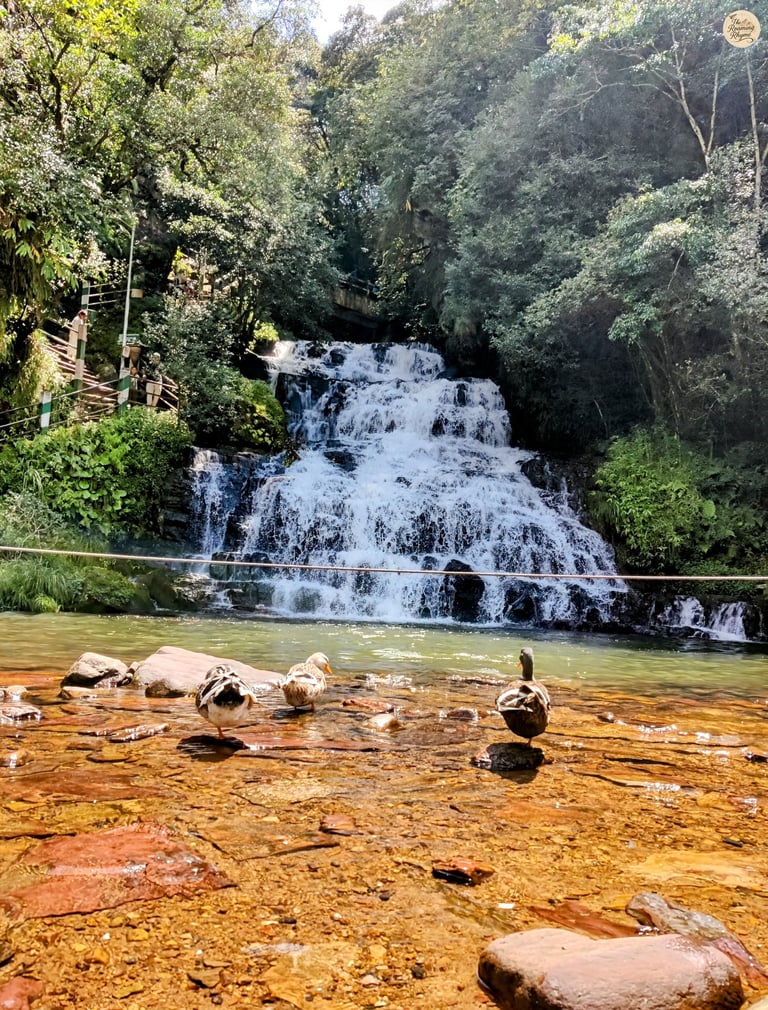

Elephant Falls, Third Tier – Shillong’s Grand Waterfall Finale in Full Flow
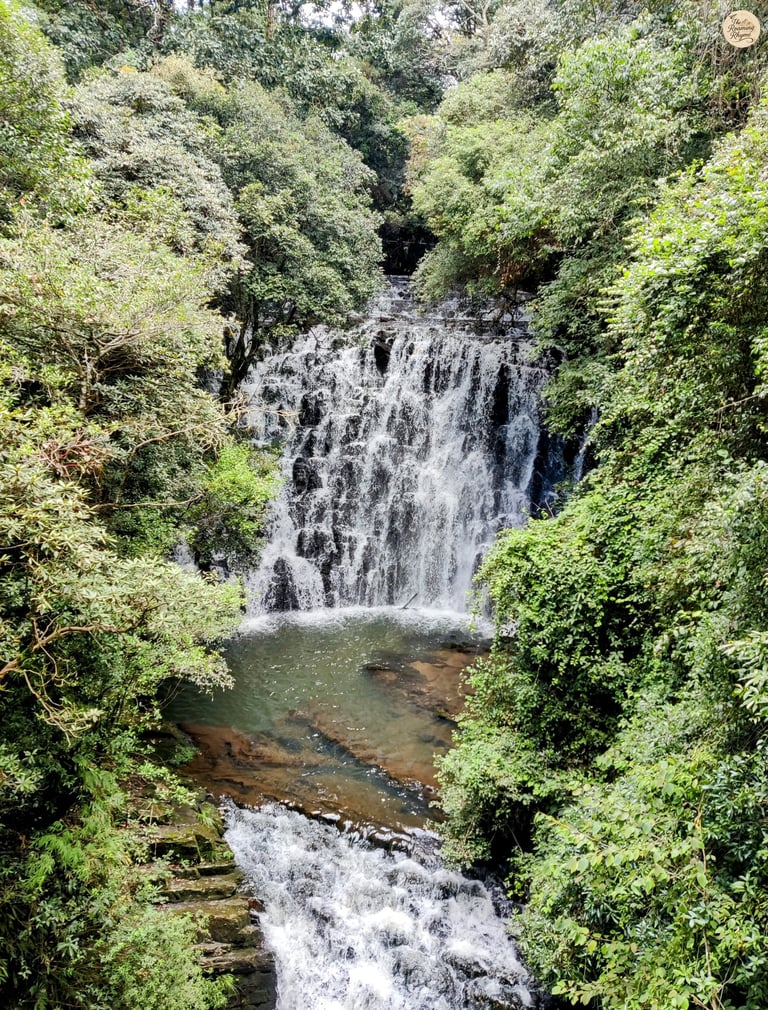

Elephant Falls, First Tier – The Hidden Beginning of Shillong’s Three-Step Wonder
Into the Sacred: Mawphlang Sacred Grove
From waterfalls to whispers, the next leg of your journey takes you deeper into Khasi heritage. About 30 km from Shillong, the road winds towards Mawphlang Sacred Grove — one of the most unique and mystical places in Meghalaya.
The Sacred Grove is an ancient forest, untouched by time and deeply respected by the Khasi people. According to tradition, nothing — not even a leaf or pebble — must be taken from the forest, for it is protected by ancient spirits. As you walk beneath its dense canopy, it’s easy to understand why. The air feels still, but not empty — like the forest is watching, listening, remembering. Moss-covered stones, gnarled tree roots, and shafts of light filtering through the green ceiling all add to its otherworldly charm.
A local guide is mandatory — not just to help you navigate the paths, but to explain the rich beliefs and stories that are part of this living sanctuary. If you enjoy walking further, you can begin the David Scott Trail from here — a historic trekking route that follows an old British-era horse cart road through forests, streams, and gentle hills.

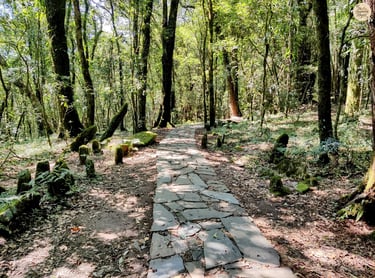
Mawphlang Sacred Grove – Where Ancient Roots, Mossy Stones, and Forest Light tell Khasi Tales
Echoes of a Tradition: Khasi Heritage Village
Right next to the sacred grove lies the Khasi Heritage Village — a peaceful space designed to showcase the traditional way of life of the Khasi tribes. Here, you’ll find beautifully built huts made using ancient construction styles — with wooden walls, thatched roofs, and tools of daily life arranged just as they would have been generations ago.
There’s also a small museum that displays traditional artifacts — everything from cooking pots to farming tools to ceremonial weapons. One corner of the village focuses on traditional archery — an important part of Khasi sports and festivals.
With its serene backdrop and well-maintained paths, the heritage village is also a great place to take photos or just sit and reflect. It’s not just a tourist attraction — it’s a living tribute to a culture that continues to thrive in the modern world.
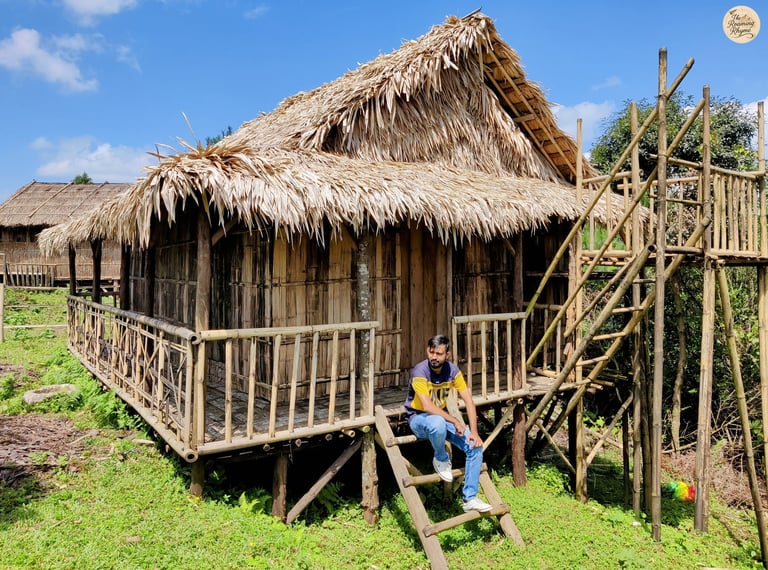

Khasi Heritage Village – Shillong’s Window to Traditional Life
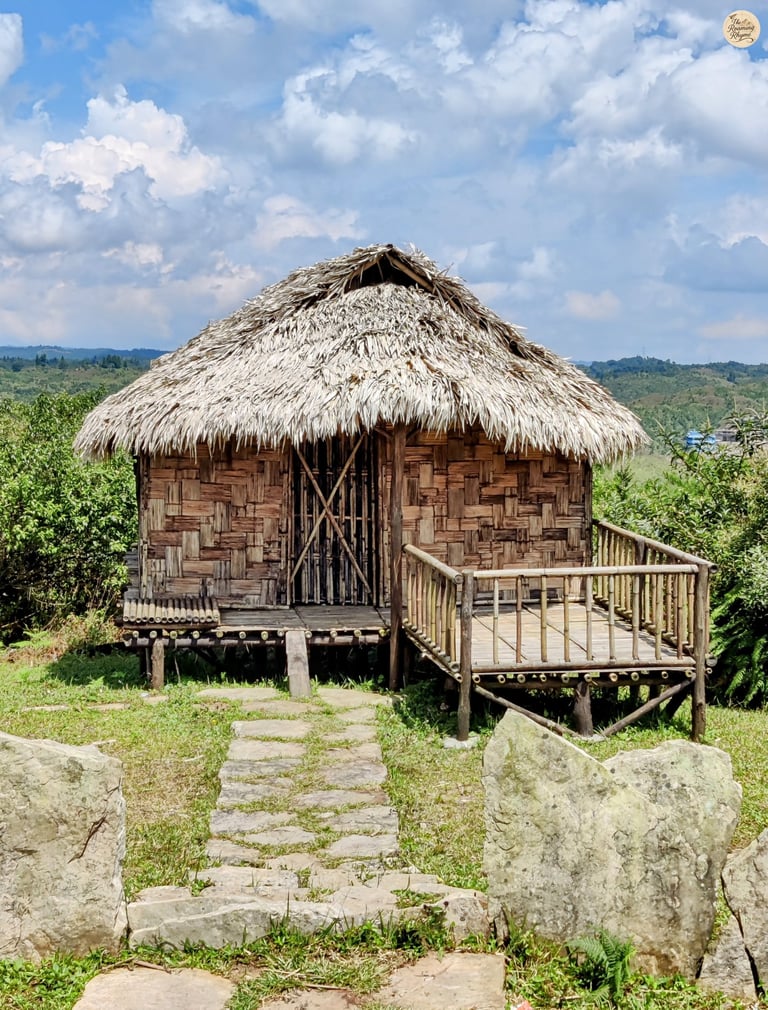

Khasi Heritage Village – Echoes of Ancient Life in Meghalaya
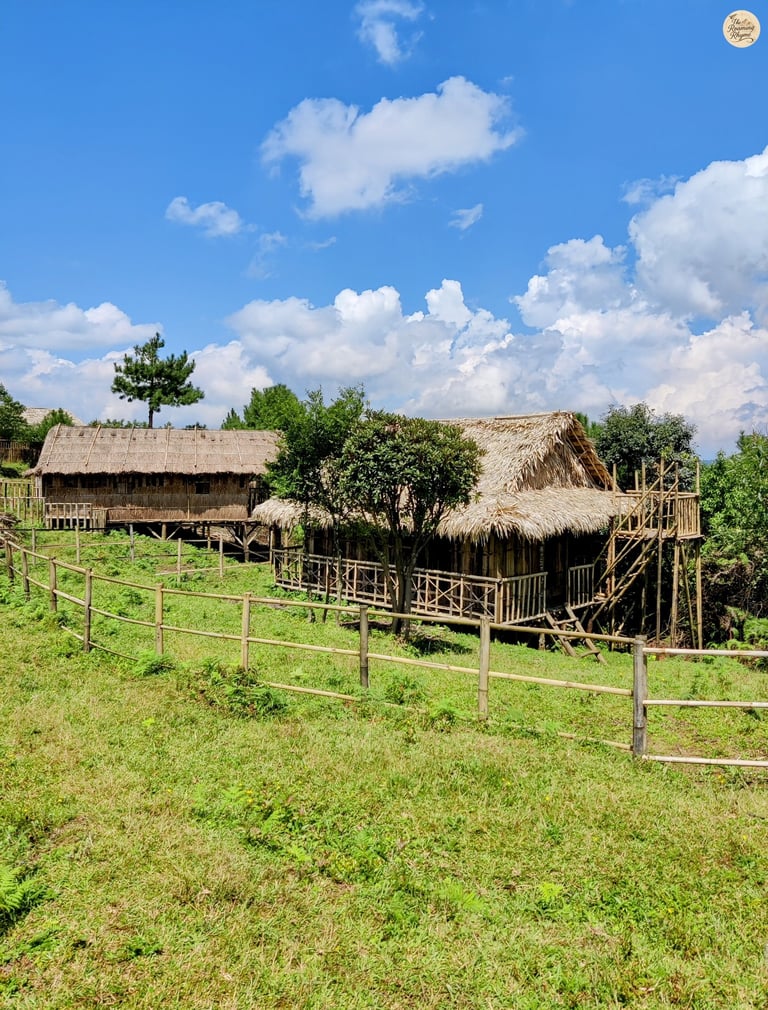

Shillong’s Khasi Huts – Where Architecture Meets Ancestry
Food for the Soul: ML 05 Café
After a morning of exploration, it’s time to rest and recharge. On your way back to Shillong, take a break at the ML 05 Café — a charming hill café named after the vehicle registration code of Shillong. It's not just about food here — it's about the vibe.
With its artistic interiors, garage-themed decor, and cozy seating overlooking pine trees, this café is one of Shillong’s most Instagrammable spots. Whether you choose their local momos, sandwiches, or a cup of rich Khasi-style tea — it’s all served with warmth. This is the kind of place where time slows down, just enough for you to catch your breath and smile.
Grace in Stone: Cathedral of Mary Help of Christians
Back in Shillong city, make your way to Laitumkhrah, where the Cathedral of Mary Help of Christians stands quietly on a hill, looking out over the valley. Its soft powder-blue walls reflect the color of the skies above, and its calm interiors offer a beautiful contrast to the bustle of the city.
Originally built in 1913, this cathedral was rebuilt in the Gothic style after a fire in 1936. Step inside, and you’ll see lovely stained-glass windows, hand-painted depictions of scenes from the Bible, and peaceful corners perfect for quiet reflection. The grave of Archbishop Hubert D’Rosario, the first Archbishop of Shillong, also lies here — a reminder of the spiritual legacy carried through generations.
Evening by the Water: Ward’s Lake
As the day begins to wind down, take a walk through Ward’s Lake, a peaceful oasis not far from Police Bazar. The lake is shaped like a horseshoe and surrounded by colorful gardens, wooden bridges, and tree-lined pathways.
This spot is perfect for a slow evening stroll. You can go boating, sit on a bench with a book, or simply watch the ducks glide across the calm waters. If you happen to visit during the Cherry Blossom Festival, the lake turns into a fairytale scene, with pink petals floating in the breeze and music performances lighting up the evening.
Return to Shillong's Embrace
As night falls, return to your stay in Shillong. Day 2 comes to a close — not with loud adventures, but with quiet stories that stay in your heart. You’ve touched the clouds, walked through sacred forests, and watched the city light up beneath your feet.
Tomorrow, the road will take you to Cherrapunji — land of clouds, waterfalls, and underground wonder. So, sleep well, for more magic lies ahead.
Day 3: Into the Heart of Rain — Cherrapunji’s Whispering Wonders
Rise early, for today, Meghalaya opens its treasure chest — a full day of cascading falls, ancient caves, mist-laced valleys, and cloud-kissed cliffs. Day 3 is your most packed day of exploration, and the road leads you to the world-renowned Cherrapunji — or as the locals lovingly call it, Sohra.
Nestled about 1.5 hours from Shillong, Cherrapunji is not just a destination; it is a feeling — of rain in the air, moss on stone, and myths in the mist. The two names — Cherrapunji and Sohra — refer to the same place, but for the purpose of this travelogue, we’ll call it Cherrapunji.
Through Mist and Valley: Mawkdok Dympep Viewpoint
Your journey from Shillong towards Cherrapunji takes you along the picturesque Sohra-Shella Road. About halfway through this 1.5-hour drive, you’ll come across the Mawkdok Dympep Valley Viewpoint, a dramatic pause that deserves more than a passing glance.
A bridge hangs quietly over the valley, and as you step out, you’re greeted by sweeping views of deep gorges carpeted in green. The cool air brushes against your face as clouds lazily swirl below. If you're up for a dose of adrenaline, there’s a zipline here that offers a heart-thumping ride across the vast valley—gliding 1,200 feet above dense foliage and hidden streams. Whether you fly or simply gaze, this is a moment to breathe in Meghalaya’s mystique.
Where Fairies Whisper: Wah Kaba Falls
About a 25-minute drive from Mawkdok Viewpoint brings you to the next marvel of the day—Wahkaba Falls. Hidden gently along the Sohra-Shella Road, this waterfall doesn't announce itself with thunderous sound. Instead, it reveals itself slowly, as you make your way down a sloped trail etched along the hillside.
There are two viewpoints here, and each offers a different glimpse of its magic. From the top, you see the water spill over the edge—a graceful leap into the void. From the sidehill viewpoint, you watch it plunge dramatically down a steep cliff, almost 170 to 190 metres below, where it vanishes into a lush, green gorge. On clear days, the sight stretches far and wide, with layers of hills rolling into the horizon.
But Wahkaba is more than just a waterfall. Local legends say that two fairies live here. As you stand quietly by the railing, hearing the water fall gently into the wind, it’s not difficult to imagine why. There's a certain dreamlike quality to the place, where mist dances with sunlight and time moves slowly.
It’s not a busy or crowded stop, which makes it feel even more intimate—like nature's little secret, shared only with those who take the time to look closer.
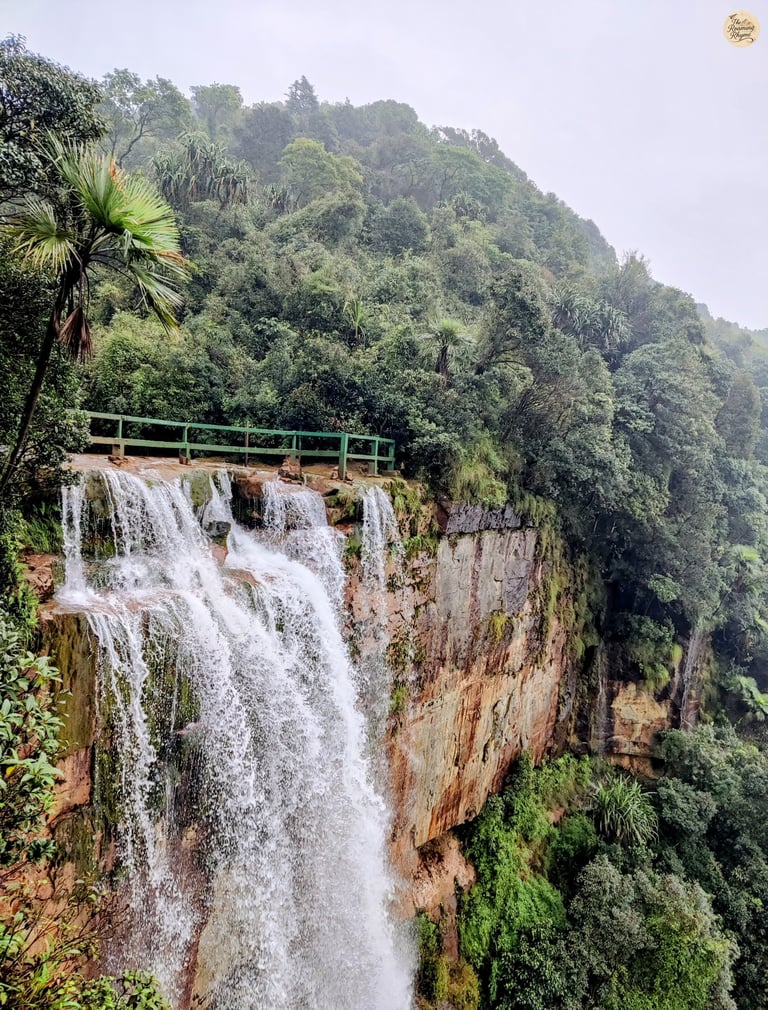

Wahkaba Falls – A Cliffside Cascade Framed by Endless Hills
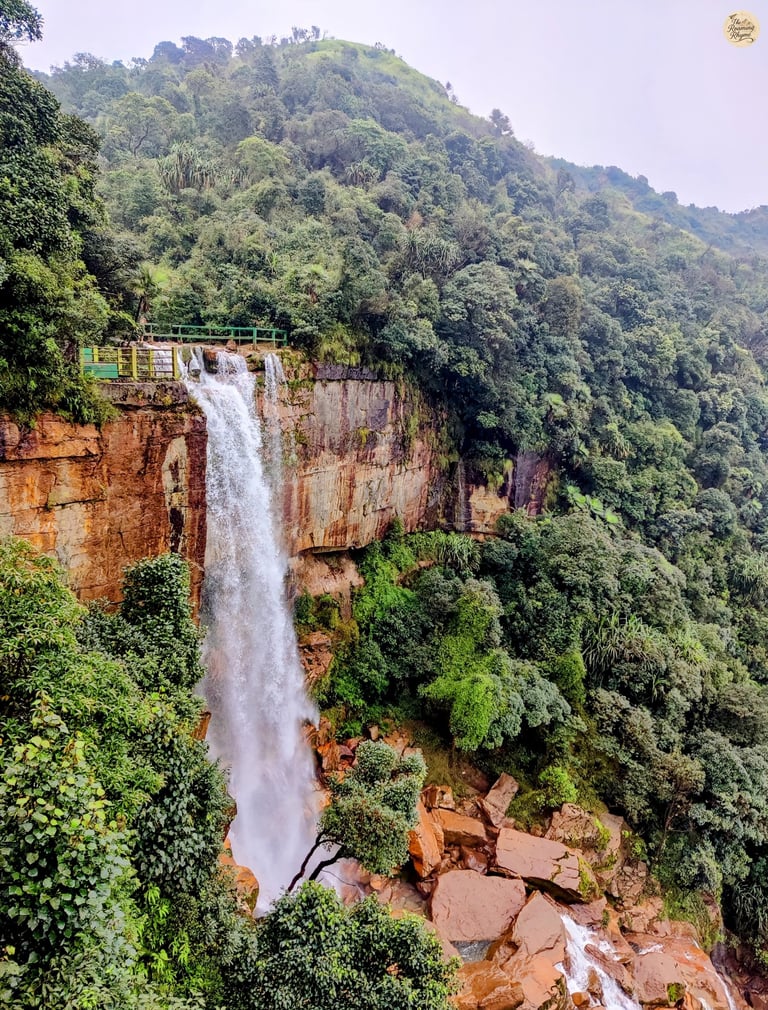

Wahkaba Falls – A Majestic Drop into Nature’s Depths
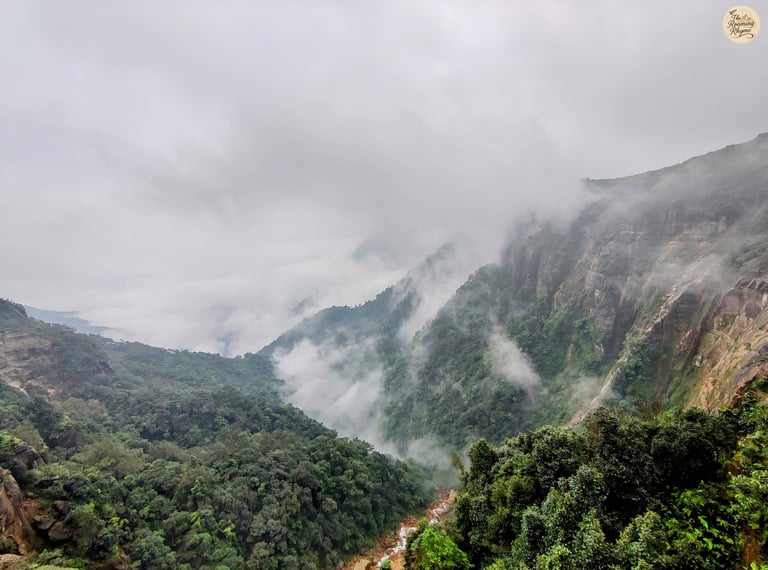

Wahkaba Falls Vanish into the Deep Valley Draped in Mist.
Legends in Stone: Dainthlen Falls
After Wahkaba, take a brief detour off the main road—just 4 kilometers ahead, followed by a bumpy 5-kilometer ride over rocky terrain—and you’ll arrive at Dainthlen Falls.
You’ll leave your vehicle near an iron bridge and walk a short way along a potholed rocky riverbed. The terrain may be rough, but the reward is unforgettable. Ahead lies a wide and mighty waterfall that thunders off the edge of Cherrapunji’s plateau into the forest below.
Dainthlen isn’t as tall as some others, but it’s the sheer volume and force that will stop you in your tracks. The falls slice through layers of hard rock before plunging down around 80 metres into the greenery below. There are viewing points on both sides—each offering a different perspective of this dramatic natural performance.
According to local Khasi legend, this was the very site where villagers fought and defeated a giant serpent named Thlen. A creature of greed and evil, the Thlen had long haunted the region. The people united, fought bravely, and killed it here—thus the name Dain-thlen (meaning the place where the Thlen was cut).
Standing by the railing, with the roar of water in your ears and the wind whipping around your face, you can almost hear the echoes of that ancient battle. It’s not just a waterfall—it’s a living myth, etched in water and stone.

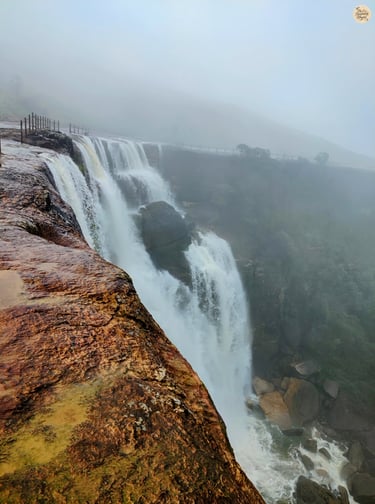
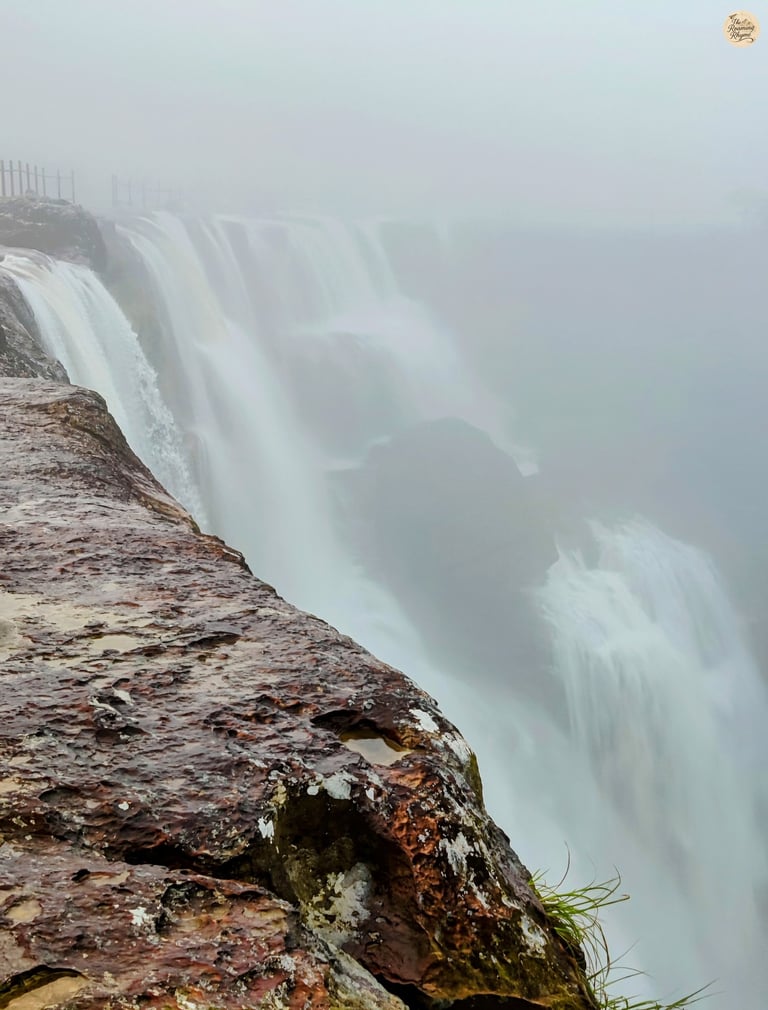

Dainthlen Falls – Cherrapunji’s Roaring Waterfall Wonder
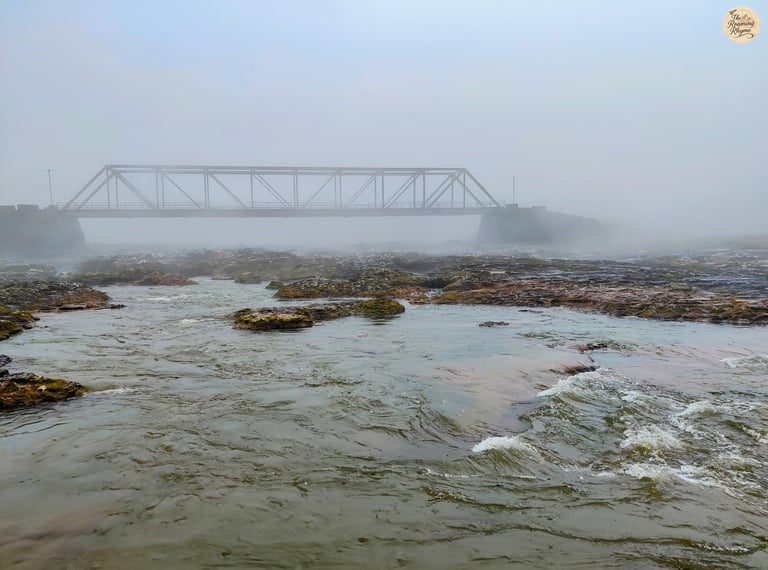

Dainthlen Falls – Power and Force in Meghalaya’s Wild Heart
Dainthlen Falls – Mighty Waters Carving Through Stone
A Stairway to Serenity: Wei Sawdong Falls
Hidden deep in the green heart of Cherrapunji lies Wei Sawdong Falls—a waterfall unlike any other. Its name, from the Khasi language, means a square-shaped pool, and this three-tiered marvel lives up to it beautifully. Each level of the fall drops into a crystal-clear pool below, forming a natural staircase of cascading water.
Reaching the falls is a little adventure in itself. The trail begins near Dainthlen Falls and takes about 20 to 30 minutes to hike. It’s steep, narrow, and a bit tricky—made up of bamboo ladders, wooden steps, and uneven rocks. But the forest around keeps you calm, its silence broken only by bird calls and rustling leaves.
As you descend, the view slowly unfolds. From halfway down, you get a stunning glimpse of all three levels of the fall flowing one below the other, framed by thick green cliffs. The water shines with a bluish-green tint, especially when the sun peeks through the canopy.
Once you reach the base, the effort feels completely worth it. Dip your feet into the cold, clear pool, take a deep breath, and simply take it all in. It’s one of those rare places where nature whispers and time gently pauses.
Lunch with a View: Orange Roots Restaurant
After all that wandering and wonder, it’s time for a warm, well-deserved meal. Just a few minutes from town lies Orange Roots, a charming restaurant popular among travelers. The food here is satisfying—North and South Indian dishes served with smiling hospitality.
Grab a seat by the window if you can; the view of the hills stretching beyond adds a gentle, scenic flavor to your plate. Recharge yourself—you’ve only explored half of Cherrapunji’s magic so far.
Ancient Echoes: The Arwah Caves
After the waterfalls, it’s time to explore something underground—the Arwah Caves, just a short drive from the restaurant. Getting to the cave is a peaceful walk through the forest, along a well-made path carved through thick greenery. At one point, the trail runs along the side of a hill, offering beautiful views of nearby valleys and waterfalls.
Inside the cave, you step into a world that feels ancient and quiet. The limestone walls hold fossils—shells and bones that are thousands of years old, frozen in time. There are lights inside to help guide your way, and you can see how flowing water has shaped the cave over the years. It’s cool and still inside, and as you walk deeper in, it feels like stepping into the past—like hearing soft echoes from a time when this land was covered by the sea.
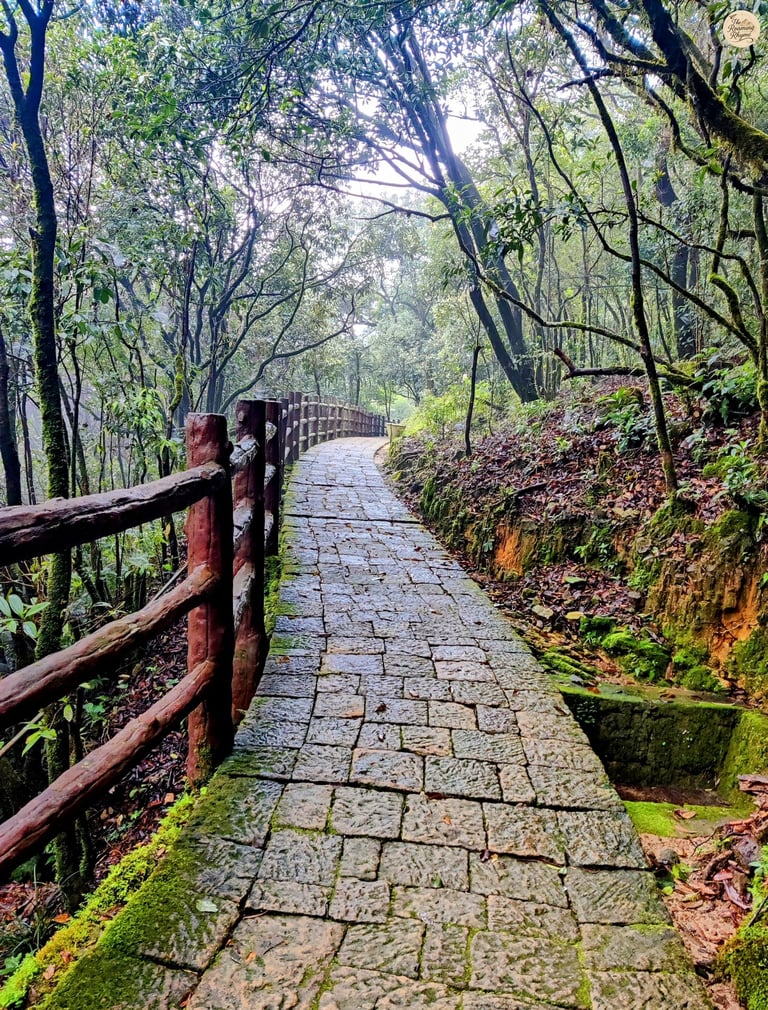

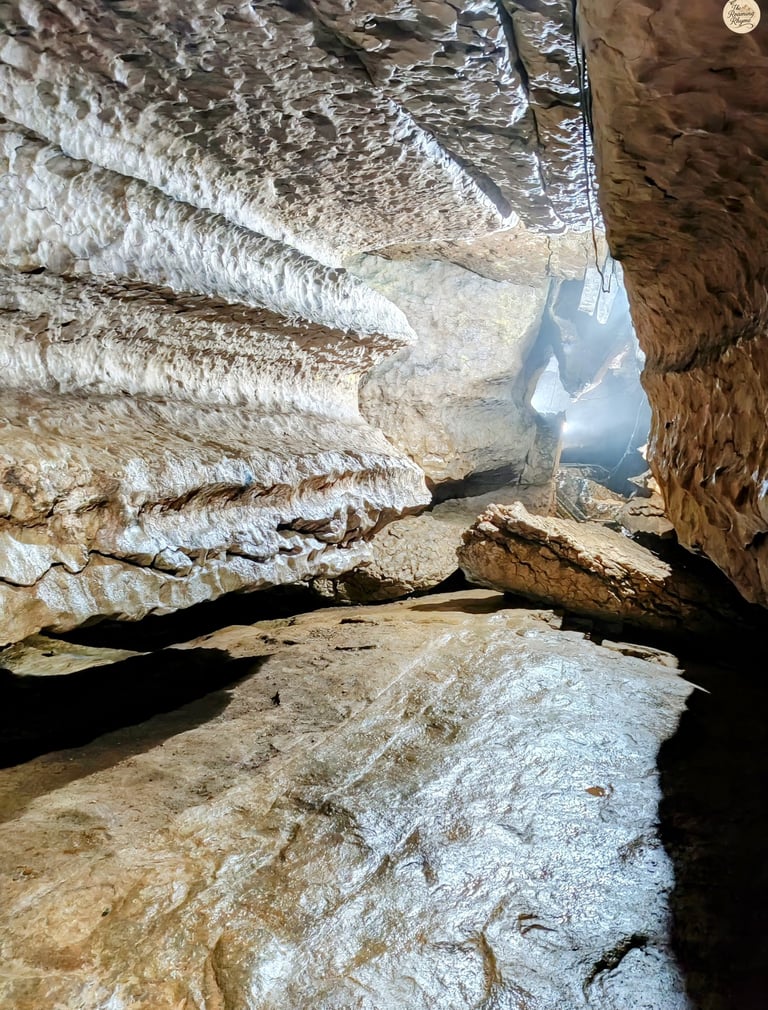

Arwah Cave – A Quiet Trail into Meghalaya’s Limestone Secrets
Into the Unknown – Exploring Arwah Cave’s Hidden Chambers
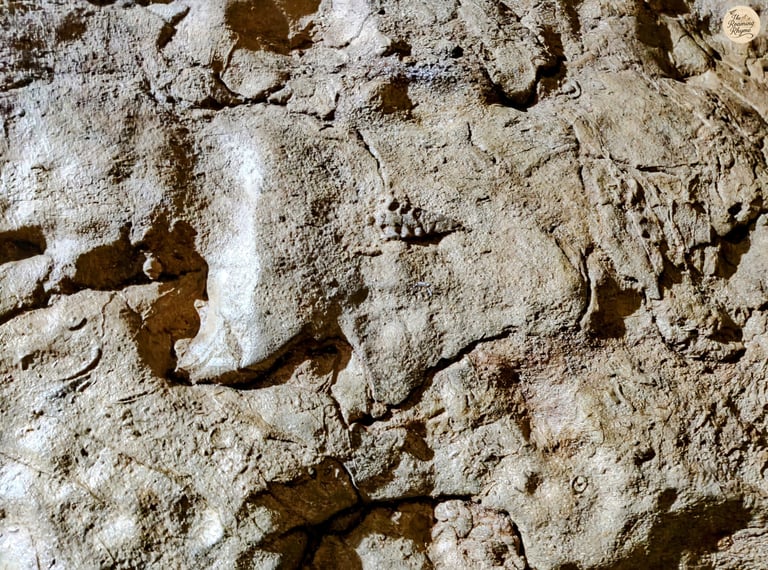

Frozen in Time – Fossil Walls of Arwah Cave, Meghalaya
The Roar of a Broken Heart – Nohkalikai Falls
Just a short drive from Cherrapunji, across a breezy plateau kissed by drifting clouds, lies one of Meghalaya’s most iconic waterfalls—the mighty Nohkalikai Falls. It’s not just the tallest plunge waterfall in India; it’s a place where beauty and heartbreak meet at the edge of a cliff.
As your vehicle rolls through the highlands, the sky opens wider and the winds grow cooler. And then, at the viewpoint, it greets you—a silken white stream of water plunging over 1,100 feet into a jade-green pool hidden in a forested gorge below. The sight is powerful yet serene, the surrounding cliffs often wrapped in drifting mist, as if the earth itself is dreaming.
The viewpoint offers panoramic angles to admire this natural wonder. If the light and mist are just right, you might even catch a rainbow forming in the spray. But beyond its breathtaking beauty, this place carries a quiet sorrow. In Khasi, Nohkalikai means “the leap of Likai.” As legend tells, a woman named Likai, consumed by grief, jumped from this very cliff. And somehow, when you stand here, you feel that story in the air—a gentle ache beneath the roar.
Nearby stalls offer a warm local touch—Sohra oranges, wildflower honey, handwoven shawls, bamboo crafts, and spices. It’s a lovely spot to pause, sip some tea, and take a piece of Meghalaya’s soul back with you.
Into the Underground: Mawsmai Cave
After soaking in the grand views of Nohkalikai Falls, it’s time to head underground once again—this time to one of the most famous caves in Cherrapunji, the Mawsmai Cave, shorter but no less fascinating than Arwah.
As you walk through a jungle trail to its entrance, the chorus of birds and insects prepares you for something primal. Inside, the limestone walls glisten faintly under the dim cave lights, shaped by thousands of years of water flowing through the earth. Some parts are wide and open, while others are narrow, and you may need to bend or squeeze through. This adds a bit of fun and adventure to the experience. You’ll notice strange and beautiful rock formations all around—twisted columns, curtain-like walls, and even natural sculptures that almost look carved by hand.
Mawsmai Cave is also known for its fossils. If you look closely, especially near the cave walls and ceilings, you might spot ancient shells or fish bones that were trapped in the rock when this entire land was once under the sea.
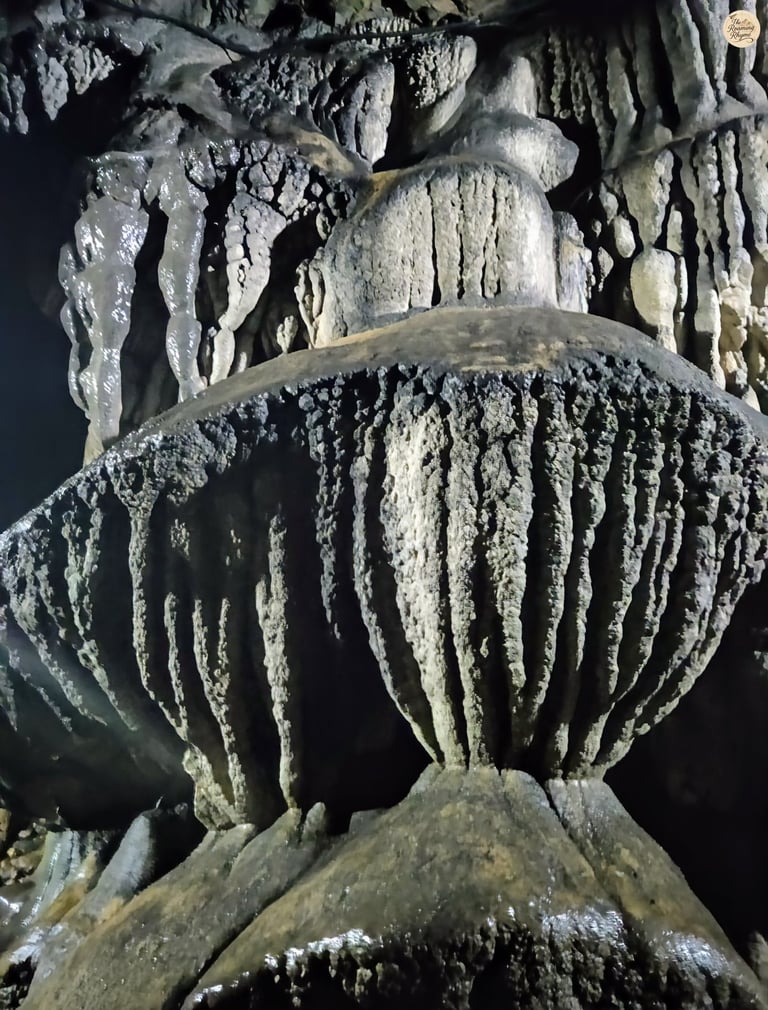

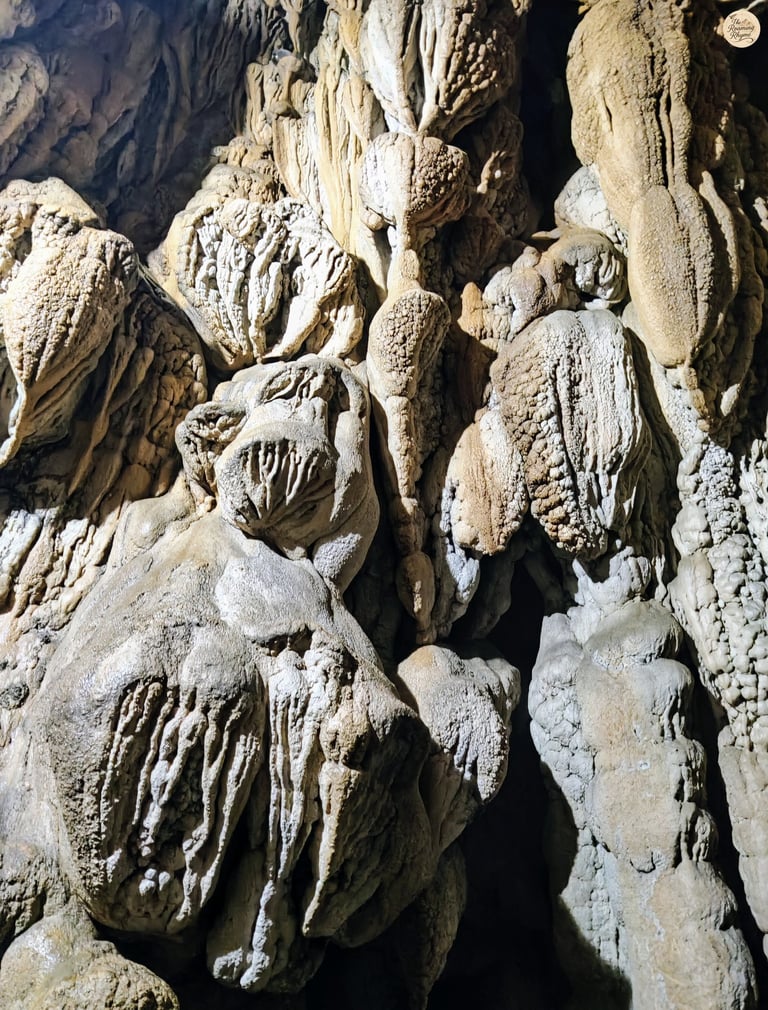

Mawsmai Cave – Twists, Columns, and Carvings by Nature’s Hand
Mawsmai Cave – Where Stone Folds Like Fabric in Meghalaya’s Depths

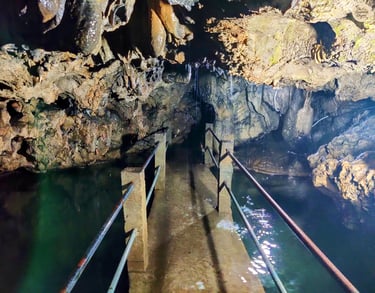
Mawsmai Cave – Crawl, Bend, and Discover Meghalaya’s Underground Maze
A Sunset for the Soul: Seven Sisters Falls
As the sun begins to dip low on the horizon and the skies start blushing with hues of orange and gold, you arrive at your final stop for the day—Seven Sisters Falls, also locally known as Nohsngithiang Falls. It’s just a short 5-minute drive from Mawsmai Cave. The moment you reach the viewpoint, the landscape seems to open up all at once. Before you lies a majestic waterfall that looks like it’s been painted across the cliffs—a wide curtain of water split into seven distinct streams, each flowing side by side in harmony, tumbling gently over the edge of tall limestone cliffs and disappearing into the misty forests below.
Close to the falls, there’s a beautifully maintained patch of greenery called Sohra Eco Park. It’s a lovely place to take a pause, breathe in the cool breeze, and admire the expansive views of canyons, rolling slopes, and the vast plains stretching out in the distance. The park’s vantage points offer the best angles for photos or simply for sitting quietly and soaking in the beauty.
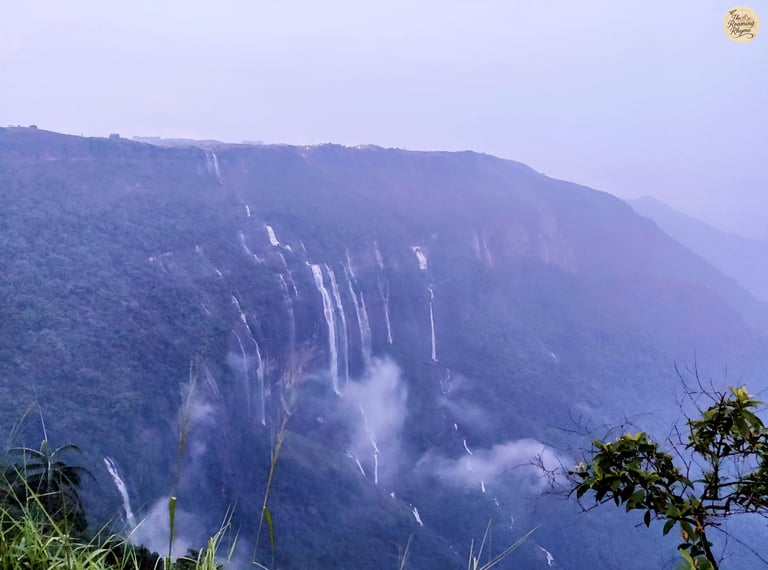

Meghalaya’s Seven Sisters – Seven Streams, One Breathtaking Fall
Back to Rest, Back to Dreams
As night descends and the hill winds cool your skin, drive back to your hotel and sink into comfort. You’ve wandered through forests, caves, and legends today—let it all settle in your dreams. For tomorrow, the trails get steeper, and the roots grow stronger. Day 4 takes you on one of the most unforgettable treks in all of Meghalaya—the double-decker living root bridge awaits.
Day 4: Into the Heart of the Forest – Trek to the Double-Decker Living Root Bridge
In Meghalaya, the day begins early. Around 4 AM, the golden light of dawn starts to filter through the clouds and mist. On Day 4, leave behind the comfort of your hotel bed and head out toward something timeless—an ancient wonder hidden deep in the green folds of Cherrapunji. The Double-Decker Living Root Bridge in Nongriat village isn’t just a destination—it’s a journey into the heart of Meghalaya’s forest soul.
Most travelers start this trek at sunrise—not only to avoid the midday humidity, but to give themselves a full day to walk, rest, soak in the beauty, and return before sunset. Some even choose to stay overnight in Nongriat for a slower, more peaceful experience. You can pack breakfast from your stay, which is what many prefer. Trust me, you'll need that early energy.
The Road to Tyrna: Into the Hills
Your first stop is Tyrna village, the base point of the famous Double-Decker Living Root Bridge trek. The drive itself is an adventure—twisting roads, hairpin bends, and views that open up to deep valleys and misty hills. Eventually, the road ends, and so begins your walk. Local guides are available at the starting point if you'd like a helping hand or a companion who knows these paths by heart.
Just ahead lies a small welcome gate—the doorway to one of Meghalaya’s most enchanting trails. The trek from Tyrna to Nongriat starts with a dramatic descent—over 3,000 stone steps winding through dense forest. That number might sound scary, but the journey is far from boring. The path leads you past fluttering butterflies, tiny Khasi hamlets, moss-covered walls, and the musical sound of water trickling through forest streams.
Local villagers run small stalls along the way, offering lime juice, fruit, cookies, and chips—just what you need when your legs begin to feel the strain. With every turn, the scenery shifts. Sometimes it’s a clearing with a panoramic valley view; sometimes it’s a shady grove buzzing with cicadas. The deeper you go, the quieter and greener it gets, as if the forest itself is wrapping you in a hug.
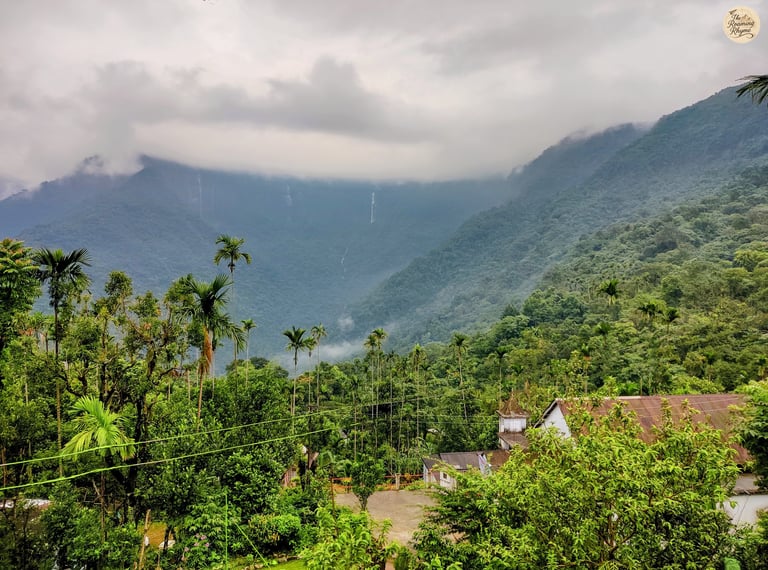

Tyrna Drive – Mist, Valleys, and Cloud-Kissed Views
A Worthwhile Detour: The Longest Single-Decker Root Bridge
After around 2,500 steps, you’ll come upon a small village clearing. Look out for the signboard pointing toward the Longest Single-Decker Living Root Bridge. Take the short detour—it’s absolutely worth it. Here, above a gentle mountain stream and nestled between massive boulders, you'll see your first living root bridge. Grown from the roots of the Ficus elastica tree, this living marvel stretches gracefully across the water—a quiet testimony to time, patience, and indigenous wisdom.
Return to the main trail and continue toward Nongriat’s Double-Decker Root Bridge. Soon, you’ll cross a series of suspension bridges. The first one sways gently, giving you a small thrill as you look down at the rocky riverbed below. The second is shorter and more stable, wrapped in vines and shaded by trees.
As you go deeper, the jungle grows wilder. The path narrows, the steps become steeper and wetter, often coated in moss. But then, just when you’re wondering how much farther, the forest opens—and there it is.

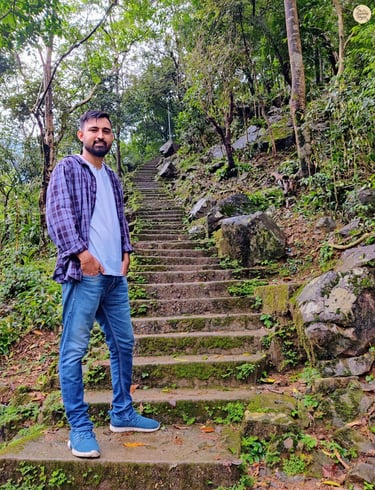
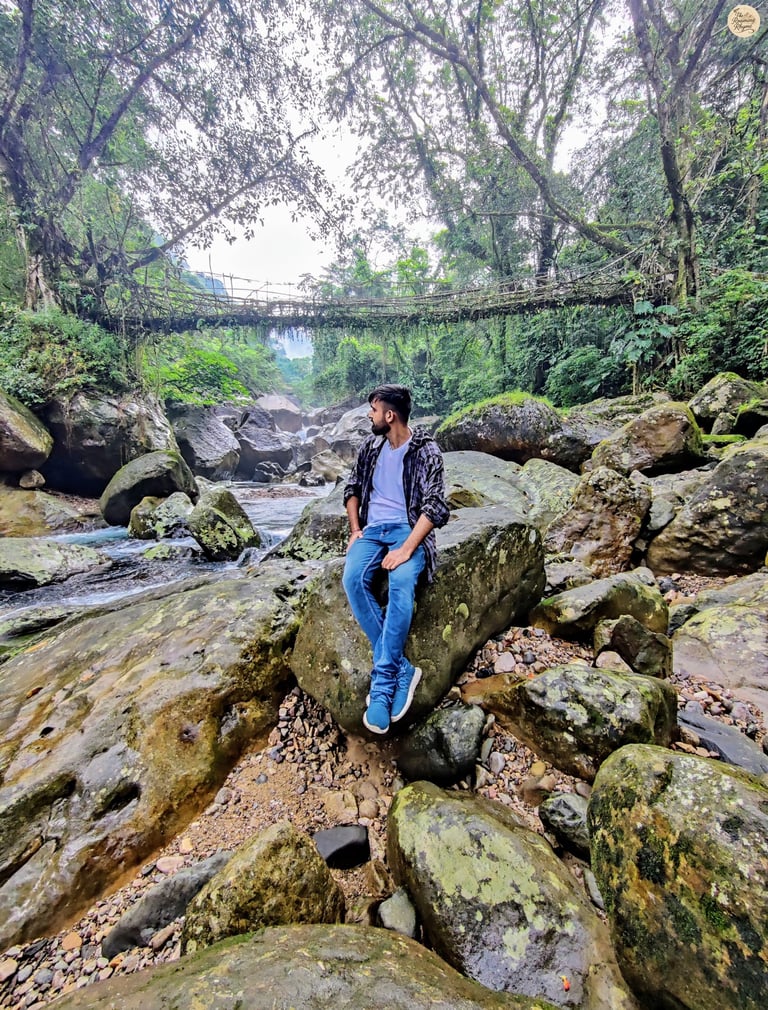

3,000 Steps Down – Into the Depths of Meghalaya’s Living Bridge Trail
Single Decker Root Bridge – A Trek Woven in Roots and Rock
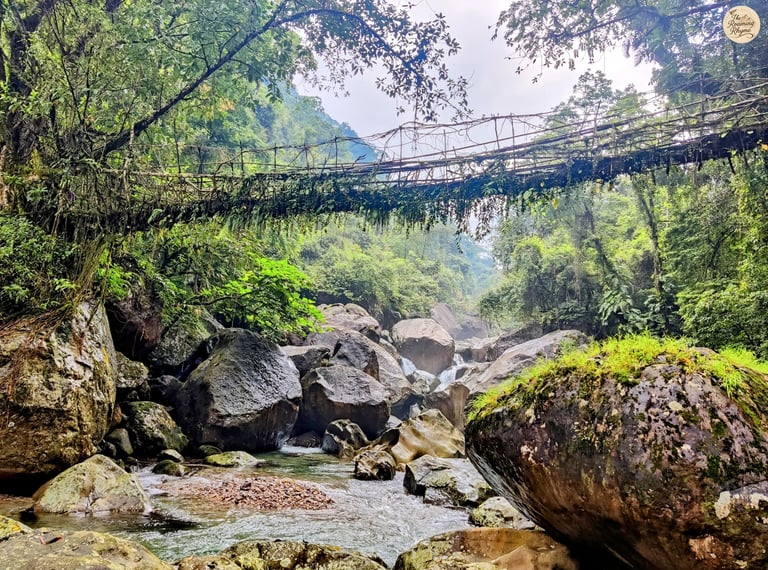

Single Decker Root Bridge – A Living Link Across the Stream
The Double-Decker Living Root Bridge: Nature’s Masterpiece
The Double-Decker Living Root Bridge of Nongriat village rises before you like a scene from a forgotten world. Two layers of living roots, grown across a stream and over one another, forming a bridge so unique that no photograph can truly capture its magic.
Surrounded by dense tropical jungle, with the murmur of water flowing beneath, the bridge feels like a dream. It’s not just beautiful—it’s alive. These living root bridges of Meghalaya are nurtured by local villagers over decades, guiding the rubber tree roots across rivers using bamboo frames. Over time, the roots thicken, intertwine, and grow strong enough to carry entire groups of people.
Some of these bridges are over a century old. Others are still growing. These natural wonders are eco-friendly, sustainable, and deeply spiritual—a perfect harmony of human craft and forest life.
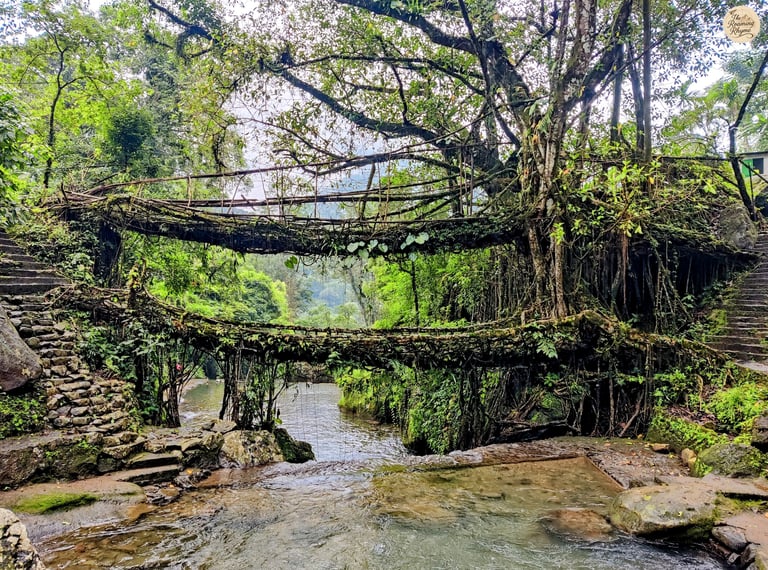

Double Decker Bridge – A Twin-Layered Marvel Grown from Roots
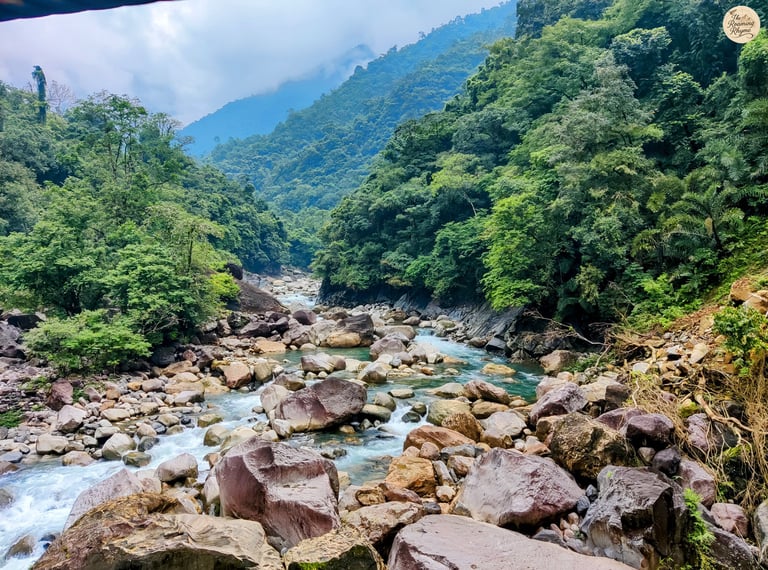

Jungle Trails and Murmuring Streams – En Route to the Double Decker Root Bridge
Rest, Refresh, and Reconnect
Just a short walk from the double-decker bridge, you’ll find a small waterfall and natural pool. Kick off your shoes, dip your tired feet in the cool stream, and let nature work its magic. Nearby stalls serve Maggi, tea, and simple local meals, which feel extra comforting in this forest hideaway.
If your heart tells you to stay a little longer, you can. There are a few homestays in Nongriat village—basic, humble, and full of warmth. Staying here overnight gives you the gift of slowness, a chance to wake up to birdsong and begin again at your own pace.
Trek to Rainbow Falls: One More Wonder
If you still have energy and time on your side, continue your trek past the bridge to visit the stunning Rainbow Falls. This section of the trail is steeper and more challenging, but absolutely worth the effort.
The path takes you past a small forest football field, over hanging bridges, through thick jungle, betel nut groves, and along turquoise-blue streams rushing through rocky gorges. It feels untouched, pure, and secret.
Finally, as you make your way to the last stretch, tired but determined, the sound of crashing water grows louder. And then—like a painting come to life—you see it.
Rainbow Falls is a tall, thunderous waterfall pouring into a glowing turquoise pool. On sunny days, the mist in the air catches the light and creates a soft rainbow right above the water—nature’s own magic trick. Stand at the safety railing and let the spray touch your face. You’ve made it. Take your pictures, make your memories.
Just note—there’s no food available here except for one small stall, and prices can be a little high. So plan accordingly.
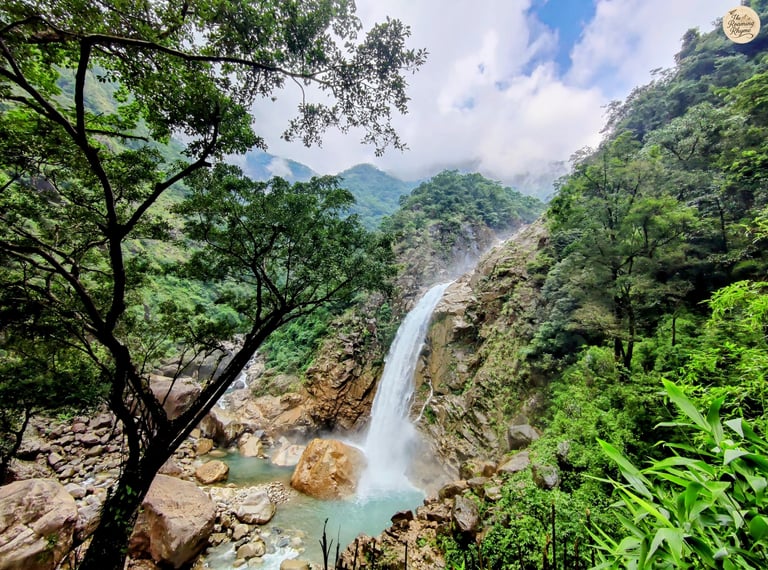

Rainbow Falls, Meghalaya – Turquoise Glow and Falling Power
The Long Way Home
After a good rest and a heart full of awe, it’s time to turn back. Descend from Rainbow Falls, pass the Double-Decker Root Bridge again, and begin the final 3,000+ step climb back to Tyrna village. This part is tough. No sugar-coating it. But every step you take upward carries the memory of all you’ve seen—root bridges, butterflies, waterfalls, and jungle trails.
Once you reach the top and your vehicle back to the hotel, there’s a quiet pride in your chest. This day wasn’t just about reaching a bridge—it was about discovering the rhythm of the forest, of slowing down and listening to the whispers of Meghalaya. Day 4 might take you deeper into the hills, but it leaves you higher in spirit.
Day 5: Crystal Rivers and Border Dreams – A Scenic Sojourn to Dawki and Mawlynnong
After four days of climbing hills, crossing root bridges, and chasing waterfalls, Day 5 of your Meghalaya itinerary offers a welcome change of pace. It’s a gentler day, shifting from the misty heights of Cherrapunji to the serene plains near the India–Bangladesh border. You can start a little late today—around 9 or 10 AM—and still have plenty of time to soak in its charm.
The Cleanest Village in Asia – Mawlynnong
Your first stop of the day is the storybook village of Mawlynnong, often celebrated as the Cleanest Village in Asia. The drive from Cherrapunji to Mawlynnong is about 75 km and takes roughly 2.5 hours. The roads are smooth and scenic, winding past lush hills and panoramic viewpoints that give you fleeting glimpses of the valleys below.
Mawlynnong, nicknamed God’s Own Garden, is more than a village—it’s a way of life. As you enter Mawlynnong, you immediately feel the difference. The narrow paths are spotless, dotted with bamboo dustbins. Not a single plastic wrapper in sight. Locals take pride in keeping their village clean—here, cleanliness isn’t a rule, it’s a way of life. Plastic is banned, smoking is strictly prohibited, and even fallen leaves are collected and composted. It’s no wonder Mawlynnong is fondly called God’s Own Garden.
Wander through its well-tended lanes, past flowering gardens and neat wooden houses. Nearby, you can visit the Nohwet Living Root Bridge, a peaceful cousin to the more famous double-decker bridge of Nongriat. Formed by guiding the aerial roots of rubber fig trees across a stream, this natural bridge blends beauty with the wisdom of tradition.
Don’t miss the Church of the Epiphany, over a hundred years old and built during British times. Tucked amid greenery, it’s a serene place to pause. If you’re feeling adventurous, climb the bamboo skywalk near the village. At the top, the view is truly special—you’ll see the plains of Bangladesh stretching far into the horizon, blending with the clouds.
There are local food stalls here serving hot Khasi dishes and simple snacks. It’s a great place to sit down for lunch, surrounded by peace, birdsong, and community spirit.
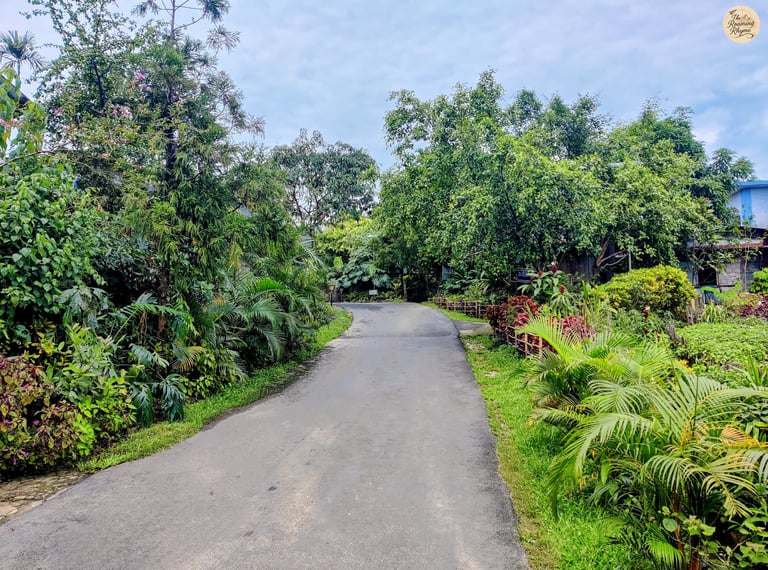

Clean, Green, and Serene – Mawlynnong Village, Meghalaya
Road to Dawki – A Border Where Cultures Touch
Post-lunch, the road leads you southward, closer to the Indo–Bangladesh border. On one side are the green ridges of Meghalaya; on the other, the wide plains of Bangladesh lying low and calm. As you travel, you’ll pass betel nut plantations, tiny waterfalls, and hillside hamlets. Along the way, a river begins to trace your journey—gentle at first, then glimmering in full view. This is the legendary Umngot River, known for its unreal, crystal-clear waters.
Eventually, you reach the riverside town of Dawki—a place where postcards come to life. The river runs like glass between rocky cliffs and fishing canoes. In the dry months, especially from November to February, the Umngot River becomes so clear you can see the pebbles on its riverbed. Locals say that boats look like they’re floating mid-air.
To truly enjoy this wonder, head to the union-run boat club near the BSF post, rather than taking random boats on the roadside. The boat ride here is serene and beautiful. You’ll glide across emerald waters, pass under a hanging bridge, and reach a soft sandy patch where you can step off, splash around, or just sit by the river.
Even if you visit right after the monsoon, like I did in September, the river may not be as see-through, but the setting is still magical. Fishermen cast their lines in age-old ways, kids swim in quiet corners, and the breeze carries the scent of the river.
There are snack stalls near the riverbank, where you can enjoy roasted corn, local pickles, or a warm cup of tea while sitting by the pebbled shore.
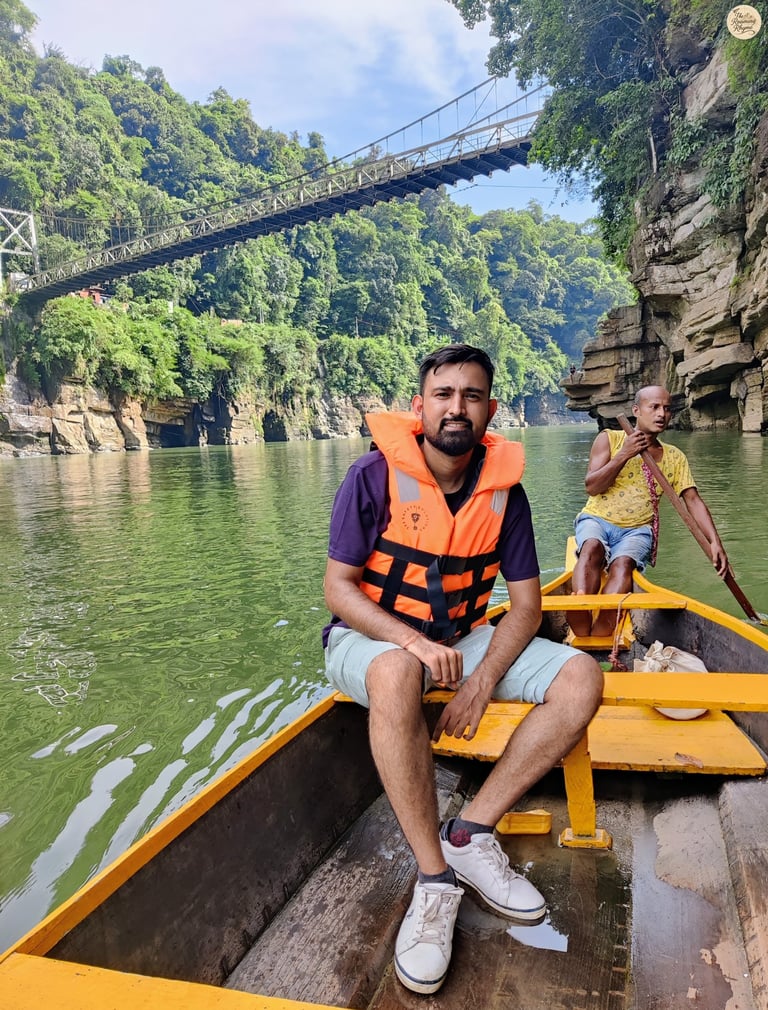

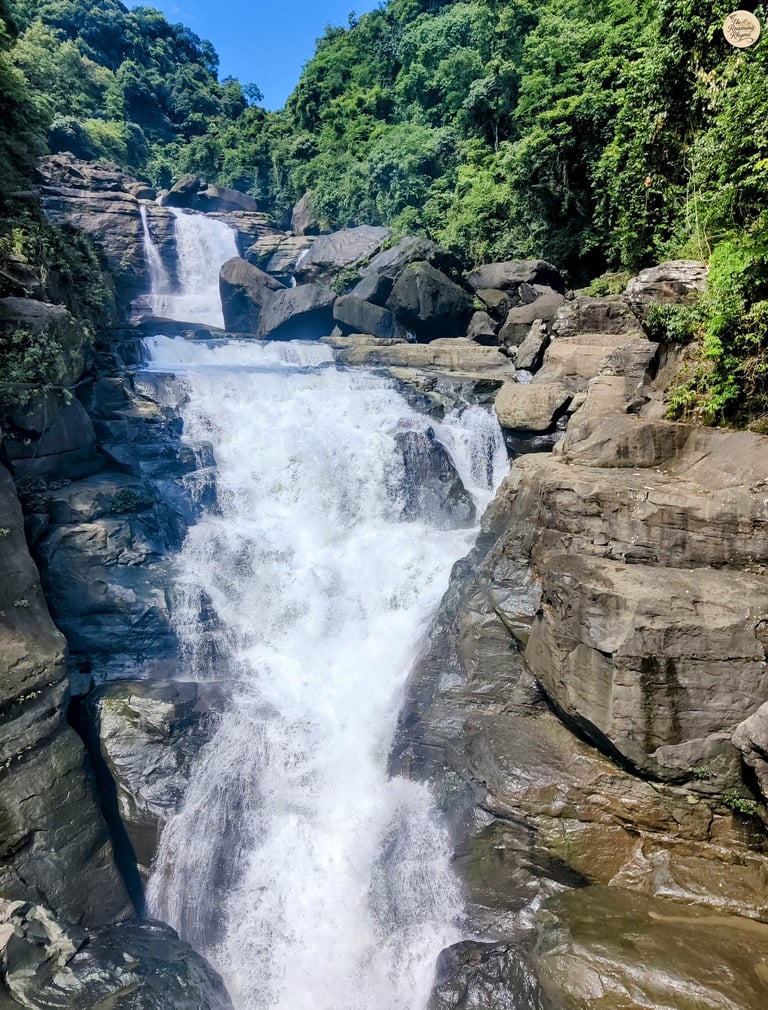

Boat Ride at Dawki – Emerald Waters and Hanging Bridge Views
Road to Dawki – A Waterfall’s Descent from Meghalaya to Bangladesh
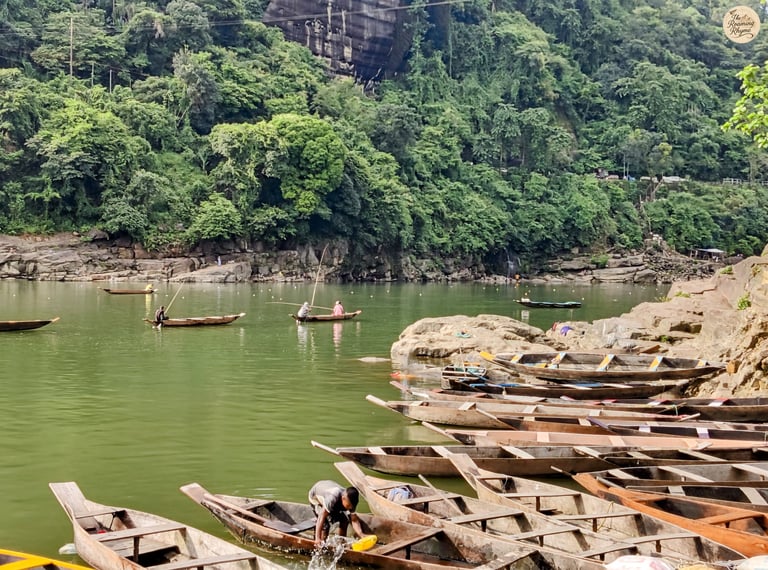

Umngot River – Monsoon-Touched, Yet Still Magical
Tamabil Border – Where Nations Meet in Peace
A few minutes from Dawki lies the peaceful international border post of Tamabil, where you can quite literally stand at the edge of India and look across into Bangladesh. It’s a calm, friendly place—no crowds or chaos, just flags fluttering gently, and soldiers chatting warmly with visitors.
For anyone interested in geography, culture, or history, visiting Tamabil is a simple but special experience. You can feel the closeness of two countries, their stories separated by lines but united by landscapes. It’s one of the lesser-known places to visit in Meghalaya, but it leaves a lasting impression.
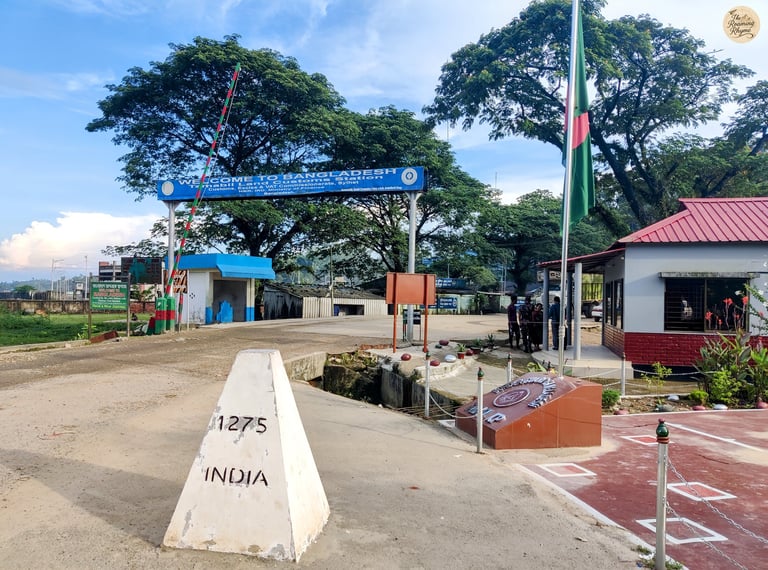

Tamabil Border – Flags Fluttering, Nations Meeting in Peace
Camping by the Umngot – Shnongpdeng’s Riverside Charm
Instead of staying in Dawki town, I recommend driving a little further to the small riverside village of Shnongpdeng. Just a short detour from the main Dawki–Jowai road, this village sits above the Umngot River and offers a more peaceful place to spend the night.
Here, you can choose to stay in a simple homestay or set up camp by the river. Many travelers opt for riverside camping in Shnongpdeng, where you can sleep under the stars, light a campfire, and hear the river whispering all night long.
The water here is clean and cool, perfect for swimming or just dipping your feet. You can go for another round of boating, try traditional fishing, or simply relax by the rocks as the day fades into twilight. The area is safe, and basic amenities are available, making it a favorite spot for nature lovers and backpackers alike.
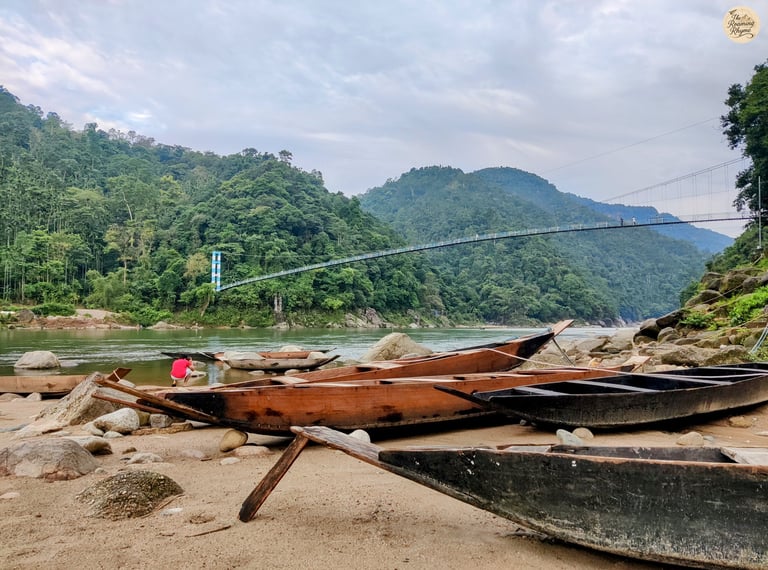

Shnongpdeng Riverside – Swim, Sit, or Just Soak in the Calm
From Quiet Villages to Roaring Falls
Day 5 ends gently—no steep climbs, no hurried treks—just slow, scenic travel across borderlands and rivers, through villages that keep their traditions alive. And as you rest in your tent by the riverbank, you can already feel tomorrow calling. The roaring blue of Krang Suri, the wild beauty of Phe Phe Falls, and the cinematic cliffs of Laitlum are waiting.
Day 6 – From Crystal Waters to Cloud-Kissed Cliffs
There’s something magical about waking up beside a river, especially when that river is the stunning Umngot River in Shnongpdeng village. As you unzip your tent and step out, you're greeted with silence only broken by the gentle lapping of crystal-clear water and the rustling of leaves in the morning breeze. The river flows soft and steady, its surface catching reflections of the sky like a glass mirror. It's one of those rare mornings where time feels slower, kinder.
Take your time to freshen up. If you're feeling brave, a dip in the chilly river can wake every cell in your body. Otherwise, just sit by the banks with your feet dipped in, watching tiny ripples carry the dawn. Breakfast is usually simple—local breads, eggs, or sticky rice with spicy chutney—but tastes far richer when eaten beside such a view.
With no rush in the air, begin your journey around 9:30 to 10 AM. Day 6 is for waterfalls, winding roads, and finally, for standing at the very edge of the world.
Krang Suri Waterfall – Where Blue Dreams Flow
Your first destination is Krang Suri Waterfall, about an hour’s drive toward Jowai. The road winds through pine-scented hills and small hamlets, and as you turn off the main road, the forest grows thicker and quieter. A short, shaded trek with steps and handrails brings you to a glimpse of something unreal—a cascade of turquoise water tumbling into a glowing blue pool.
Krang Suri Falls is not just one of the best waterfalls in Meghalaya, it feels like a natural swimming pool carved by magic. The rocks around are mossy and smooth, and you can sit by the poolside or even walk right up to the boulders where the water falls. Sunlight streaming through the trees dances on the surface, and on clear days, rainbows form in the mist.
Whether you're here to swim, take photos, or just sit quietly and listen to the sound of water echoing through the forest, Krang Suri gives you a moment of calm you'll want to bottle up and take home.
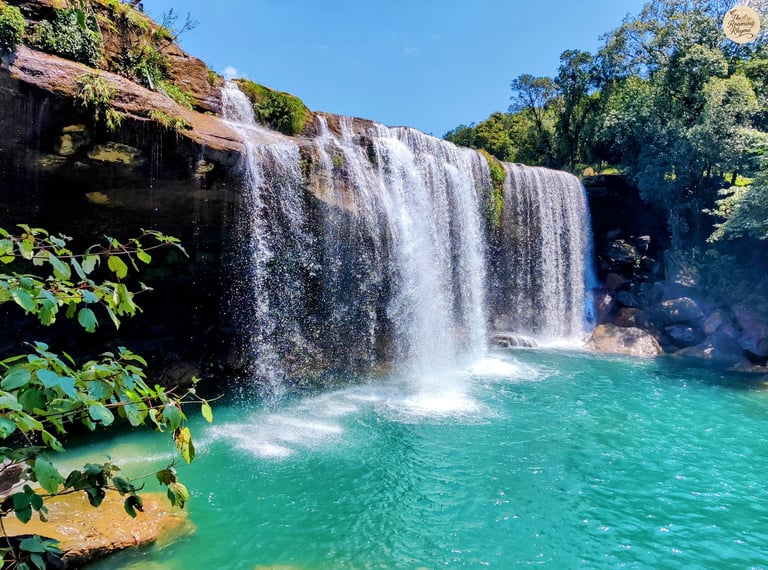

Krang Suri Falls – A Blue Jewel in Meghalaya’s Forests
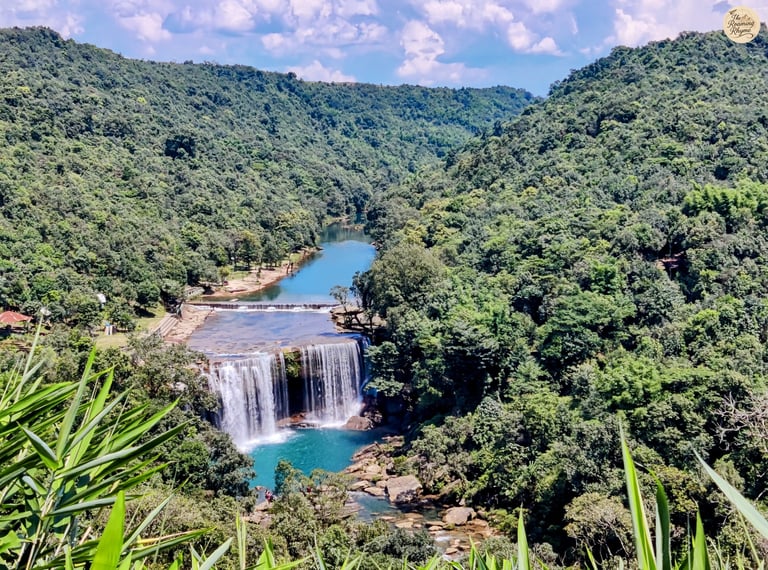

Krang Suri – Where Waterfalls Glow in Shades of Blue
Phe Phe Falls – A Walk into Paradise
After drying off and sipping some tea at a nearby stall, head back on the Jowai road for another half-hour drive. Soon, a trail leads you toward your next wonder—Phe Phe Waterfalls, tucked near Shkentalang village in the West Jaintia Hills.
The name Phe Phe means “Paradise” in the Jaintia language—and that’s exactly what this place feels like. The walk to the falls is short and scenic, cutting through bamboo groves and gentle hills. When you reach, a breathtaking two-tier waterfall welcomes you, its water blue and shimmering under the daylight.
Unlike many other waterfalls, the magic of Phe Phe is in its peaceful surroundings and the way the landscape wraps around you like a hidden sanctuary. You can sit with your feet in the stream, close your eyes, and just listen—to the roar of the falls, the birdsong above, and the whispers of wind across the hills.
It’s one of those places in Meghalaya where time feels suspended—ideal for anyone seeking raw nature and quiet joy.
Jowai – Quick Stops and Comfort Bites
On your way through Jowai town, take in the everyday charm of the Jaintia Hills region—small markets, laughing children, and fruit vendors along the roadside. You can pick up some roasted corn, local fruits, or even warm fritters from a roadside cart.
Not far from the town, you’ll find a quirky little stop—Hyperfuse Café. With a vintage car perched over the entryway and cozy interiors, it’s a fun, automobile-themed café serving hot noodle soup, momos, fried rice, coffee, and more. Perfect for a late lunch before your final leg of the day.
Laitlum Canyon – At the Edge of Earth and Sky
From Jowai, a scenic 2-hour drive brings you to your final destination of the day—and perhaps the most unforgettable one—Laitlum Canyon, just 24 km from Shillong. Reach here before twilight for the best experience, when the sky begins to soften into gold and pink.
Laitlum translates to “The End of Hills,” and true to its name, it feels like you’re standing on the very edge of the world. The canyon opens up into vast valleys and endless gorges, with layered hills stretching out as far as the eye can see. The clouds drift low here—sometimes wrapping you in fog, other times clearing up to reveal sweeping, cinematic views.
Local legends speak of ancient spirits that once walked these hills, and as you stand there, it's easy to believe. Everything feels larger than life—the cliffs, the silence, the sheer drop into green folds below. Tiny villages can be spotted far down in the valley, their stair-like paths snaking into the mist.
Laitlum Canyon is a photographer’s paradise, a trekker’s playground, and a poet’s dream. It's the perfect place to reflect on the journey you've taken across Meghalaya. The sunset here isn’t just a daily event—it’s a show, with clouds as the canvas and the horizon as a painter’s brush.
Take your time here. Sit by the edge, let the wind play with your hair, and watch the sun dip below the hills. It’s the kind of moment that stays with you—not in pictures, but in feeling.
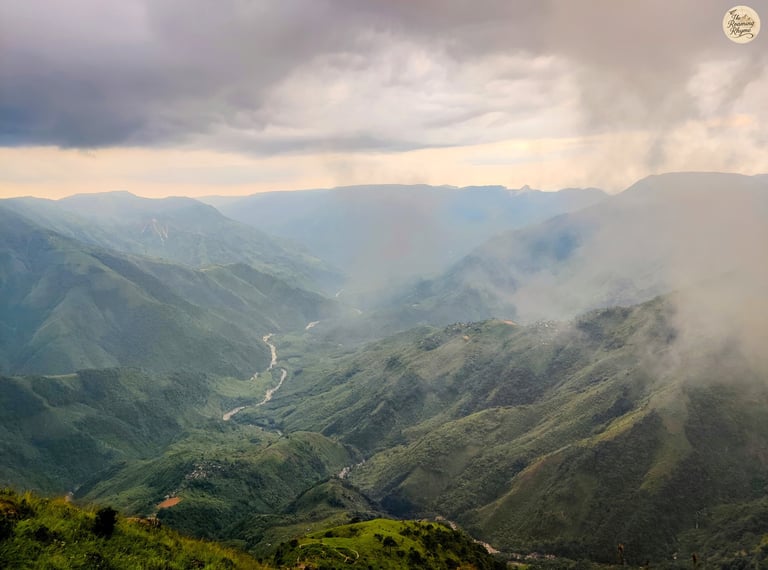

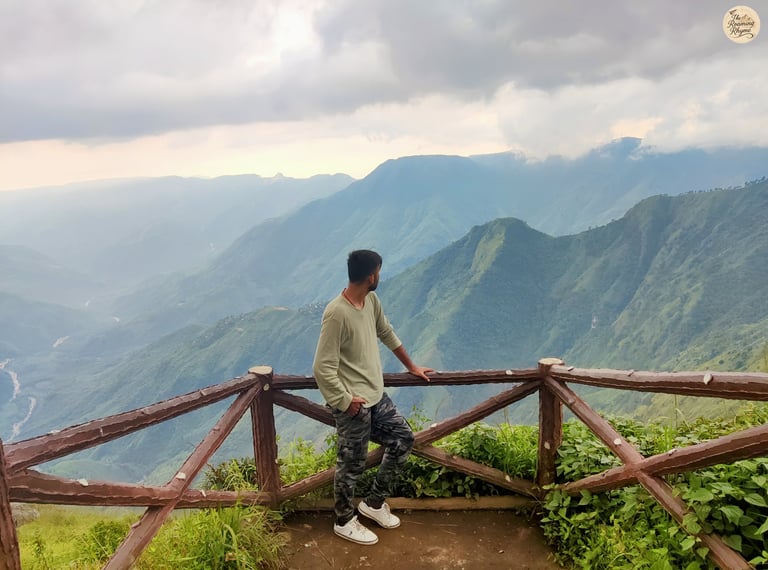

Laitlum Canyon – At the Edge of Hills, Wrapped in Clouds
Cinematic Views and Cloud-Kissed Cliffs – Laitlum Canyon
A Night to Remember – Goodbye, Meghalaya
As the last light fades, it’s time to head back to Shillong or continue toward Guwahati, depending on your plan. If you’re catching a flight or train the next day, Shillong makes for a comfortable overnight stop. And if time allows, consider a brief visit to Kamakhya Temple in Guwahati before you journey home—it’s a sacred, powerful way to close your chapter in the Northeast.
As this journey draws to a close, it leaves behind more than memories—it leaves behind a rhythm.
From the misty mornings of Cherrapunji to Dawki’s crystal-clear waters and Laitlum’s golden sunsets — Meghalaya felt like a poem written by nature itself. Every winding road, every raindrop, and every warm smile added to the magic.
If you're planning your own Meghalaya adventure, may these words help you slow down, breathe deep, and wander mindfully through this land of clouds.
The journey may pause, but the echoes of waterfalls, the scent of pine, and the silence of the canyons will linger on.
Until next time, keep chasing stories — and may your feet always find paths worth wandering.
Share Your Thoughts – We’d Love to Hear From You!
Every journey is better when shared.
We hope you enjoyed this travel story — now, we'd love to hear yours! Share your experience, suggestions, or feedback and help us make our travel tales even better.
